Marine EM Survey of Fluids in the Alaskan Megathrust
aka EMAGE - ElectroMagnetic Alaskan GeoPRISMs Experiment
Steven
Constable,
Kerry
Key,
Samer
Naif ....... (here's a link to Kerry's
blog)
The goal of this project is to map water inside deep faults beneath the Alaska
Peninsula where the Pacific tectonic plate is being subducted underneath the North
American tectonic plate. Water trapped between the plates is thought to play an
important role in controlling friction along the plate boundary and may explain large
variations in earthquake activity along the Alaska Peninsula. This study will collect
seafloor electromagnetic geophysical data to image the distribution of water in the
sediments and crust along the plate boundary, with the goal of understanding how the
transport and release of water in this critical region may regulate earthquake behavior
and plate slip. This work is funded by the National Science Foundation (thanks NSF!).
Here's an attempt to explain to a non-scientist what we do (4.7 Mb pdf)
Steve's blog (days posted from the bottom):
Tuesday June 25.
The scenic route home:

We took the scenic route home as promised, stopping to test the CTD system and carry out some more
man overboard drills. Chris and Jake, with some help from their friends, have done a good job of preparing
for the offload, which will start when we tie up in Seward tomorrow morning at 08:00 or thereabouts. The seafloor
instruments have all been double-stacked to reduce their footprint in the two 40' shipping containers
they will travel home in. Plans have made for eating, and perhaps drinking a beer (or two) tomorrow night
in town. With no more work to do, people are looking forward to that.
Bo'sun Paul preparing to recover a man overboard, and the boat crew in action:
 
It is conventional to give a shout-out to the galley crew, since on a 32-day cruise the food is always a
big deal, and the food is generally good on the UNOLS ships. But at the risk of upsetting my colleagues back at
Scripps marine operations, the food this trip has been exceptional. The ingredients are not what you normally find
in ship's food - they even bought fresh lemongrass aboard. We have vegans, vegetarians, pescevorians, and your common
or garden omnivore, all well taken care of. Thanks Mark, Marc, and Julian!

Sunday June 23.
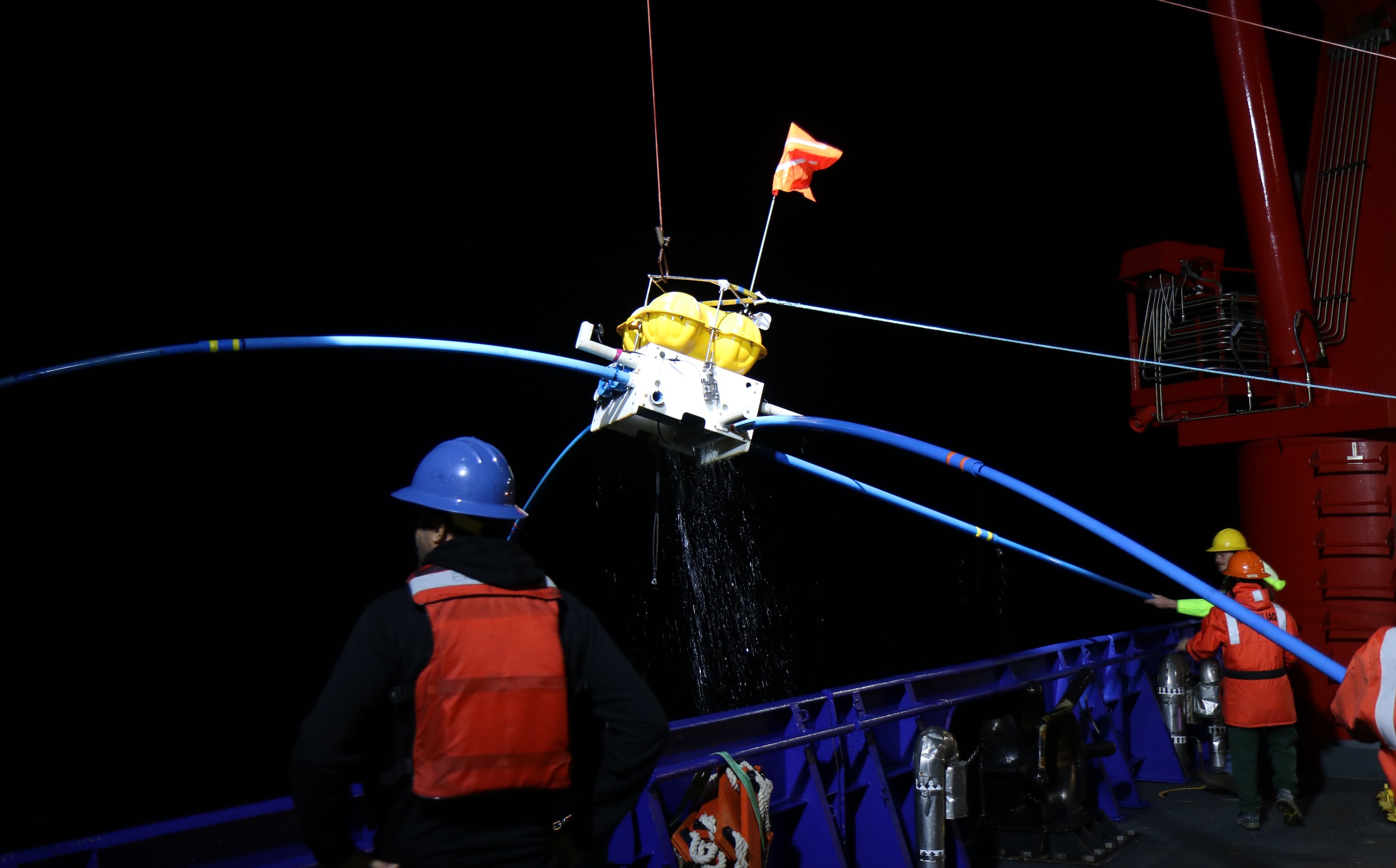
Steelhead is back! On June 4th I mentioned that we had an instrument stuck on the bottom. Its name is Steelhead - followers
of my blogs will know that I name my instruments after animals. For a long time it was Australian animals, but when Schlumberger
donated Scripps over 100 instruments, we ran out of Aussie names and Jacques started calling them after fish. Seems appropriate.
Having finished the shallow water SUESI tow with no further problems, we then recovered all the seafloor instruments on that line, also with
no further problems, and started to head for home via Steelhead. We sat over the instrument sending release commands at various power
levels, with no luck until Jake tried a trick (switching from the ducer in the well to the hull ducer, for those that care about these
things), a trick that worked. Steelhead's acoustic unit was only occasionally responding before, but as soon as it left the seafloor it replied
reliably, so our best guess is that it was just sitting in a hole or whatever. Still a bit of a mystery, but we were happy to stay up until
1 am to bring Steelhead back aboard and finish up our EM work. Between Samer's last project early this year in New Zealand, and this
one, we've had over 300 consecutive deployments and recoveries with no losses.
Because of good weather and some of the SUESI issues, we've finished early with almost everything accomplished, and were hoping
to get back to Seward a day early to have a celebratory drink (or two), but getting in early mucks up the UNOLS funding algorithm
a bit, so we're collecting some bathymetry data in the holes in the map, and plan to take the scenic route home in the passage north
of Kodiak Island. Should present some photo opportunities, so stay tuned.
Ships in the night:

We are not the only ones studying the Alaska Megathrust. Last night (well, what passes for night at the solstice in Alaska)
Samer caught sight of the R.V. Langseth doing some seismic work up here. He couldn't resist taking a photo, although it was rather
pushing the limits of my tele lens.
Wednesday June 19.
Bo'sun Paul riding the A-frame:

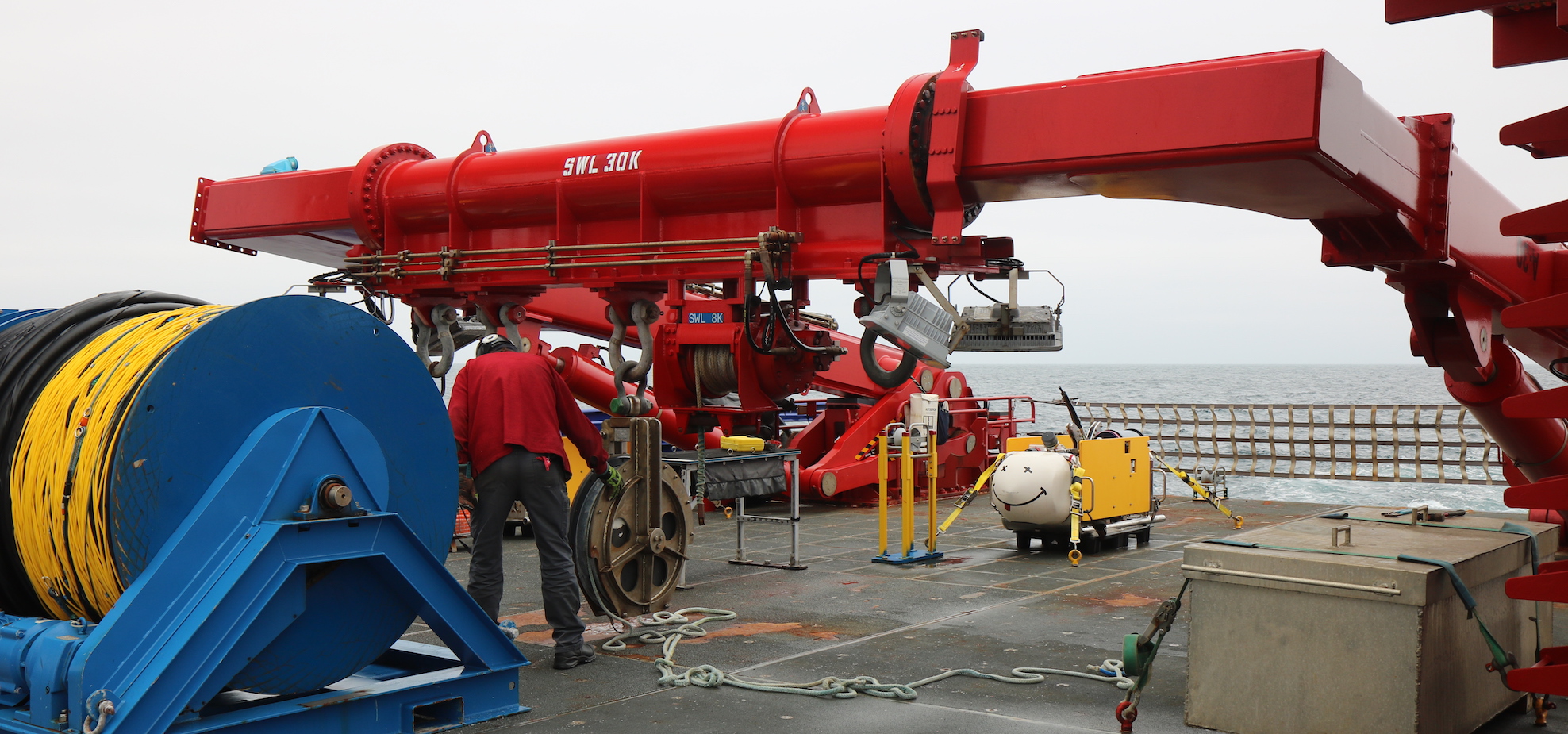
The Sikuliaq's A-frame does the neat trick of dropping to the deck, allowing the blocks to be switched out, etc.
We are now all finished with SUESI, who is packed up ready to go home, and are heading for the final set of seafloor
instrument recoveries.
Pavlov at sunset:
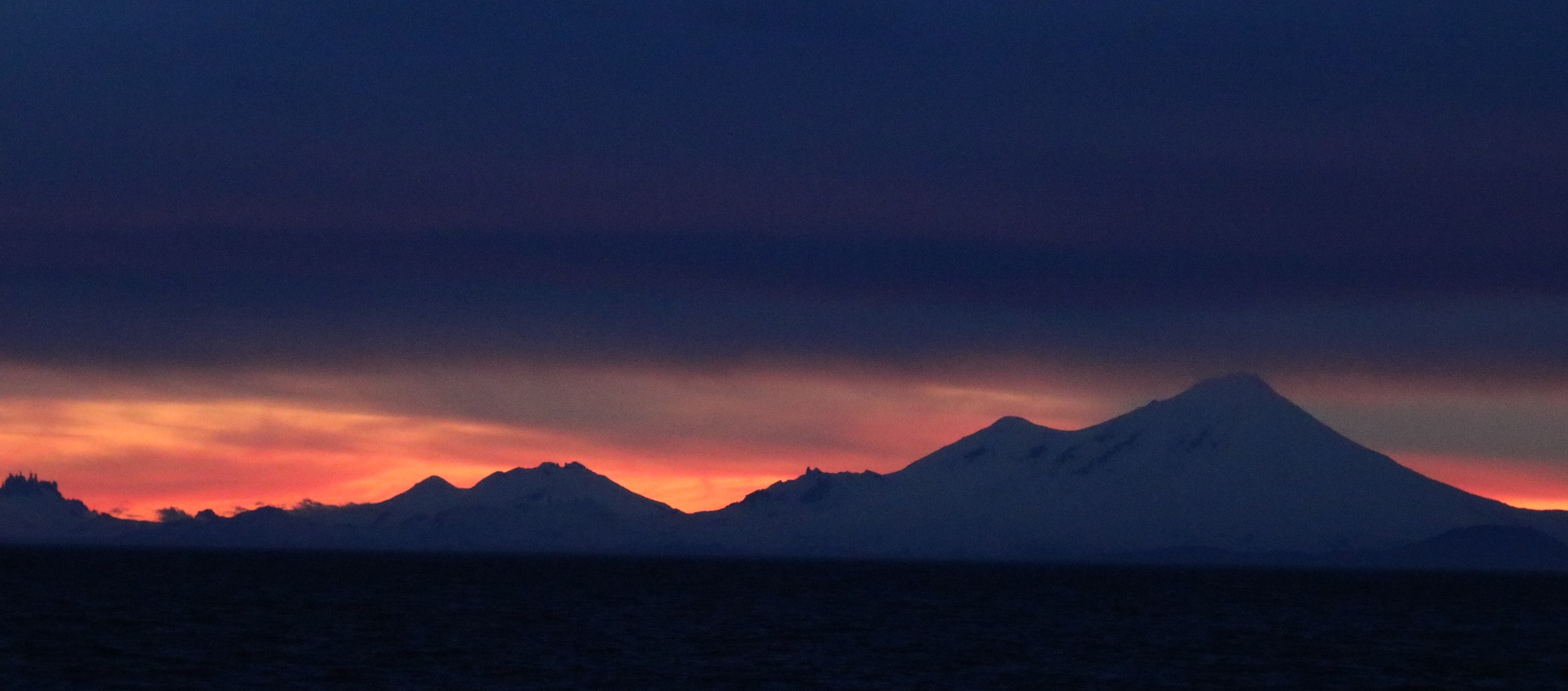
I missed it, because I went to bed early to be up for the last SUESI recovery after breakfast, but Samer took some photos
of a very nice sunset. Pavlov volcano again. The little crinkly bits to the far left of the photo are the Aghileen Pinnacles in the
Izembek National Wildlife Refuge.
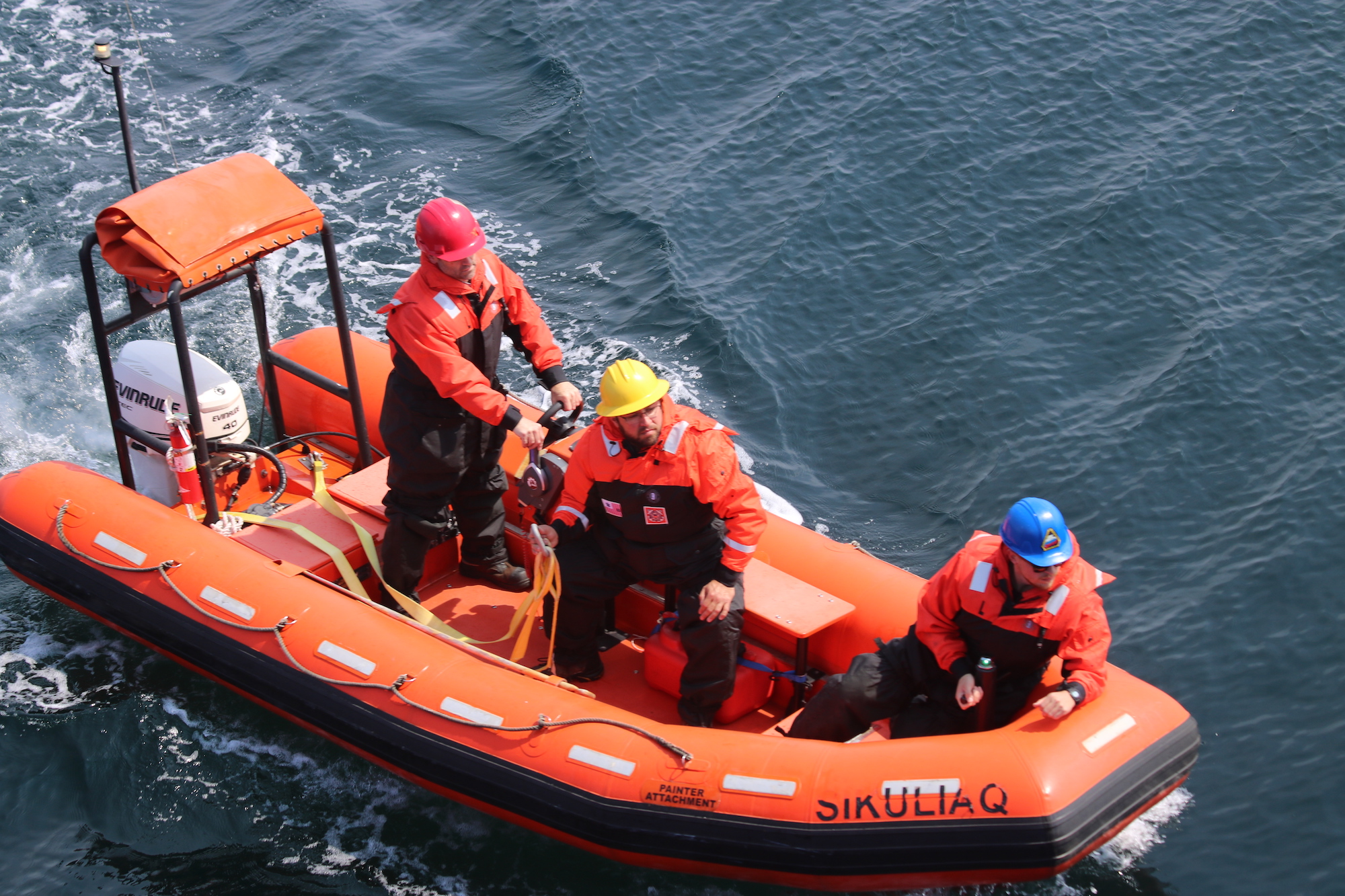

For the SUESI surface tow, we put a couple of GPS beacons at the tail end of the array so that we know where the cross-currents
are pushing our gear. Unfortunately, we didn't put enough floatation on them, and at speeds of more than about 0.9 knots, they tended
to pull under the water (GPS doesn't work underwater). Fortunately, the ship was willing to launch the rescue boat to add some floatation
in real time. Jake volunteered for the job, and go to wear his working immersion suit ("Mustang suit") for the first time.
Monday June 17.
Last dive:
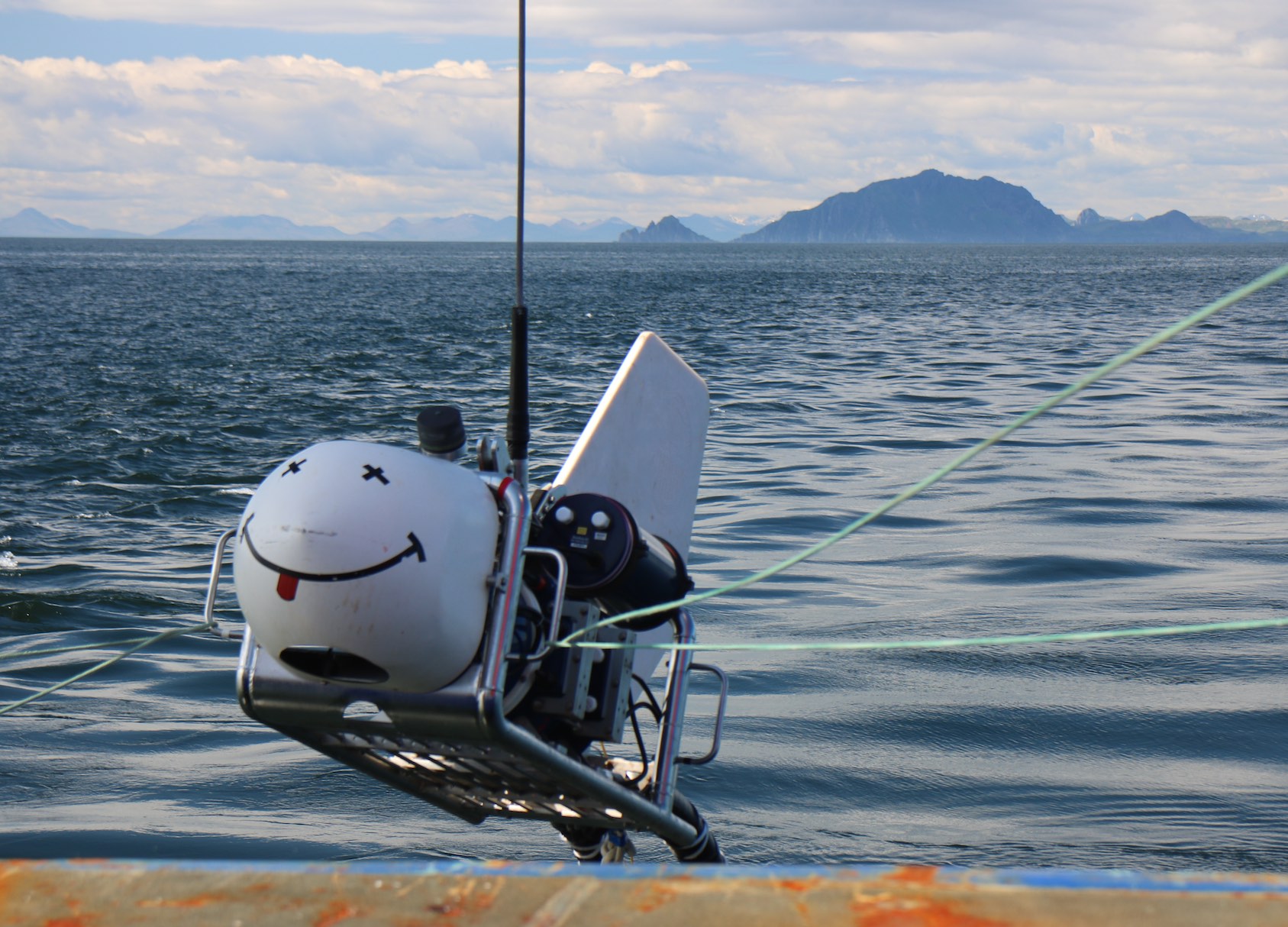
Orcas!
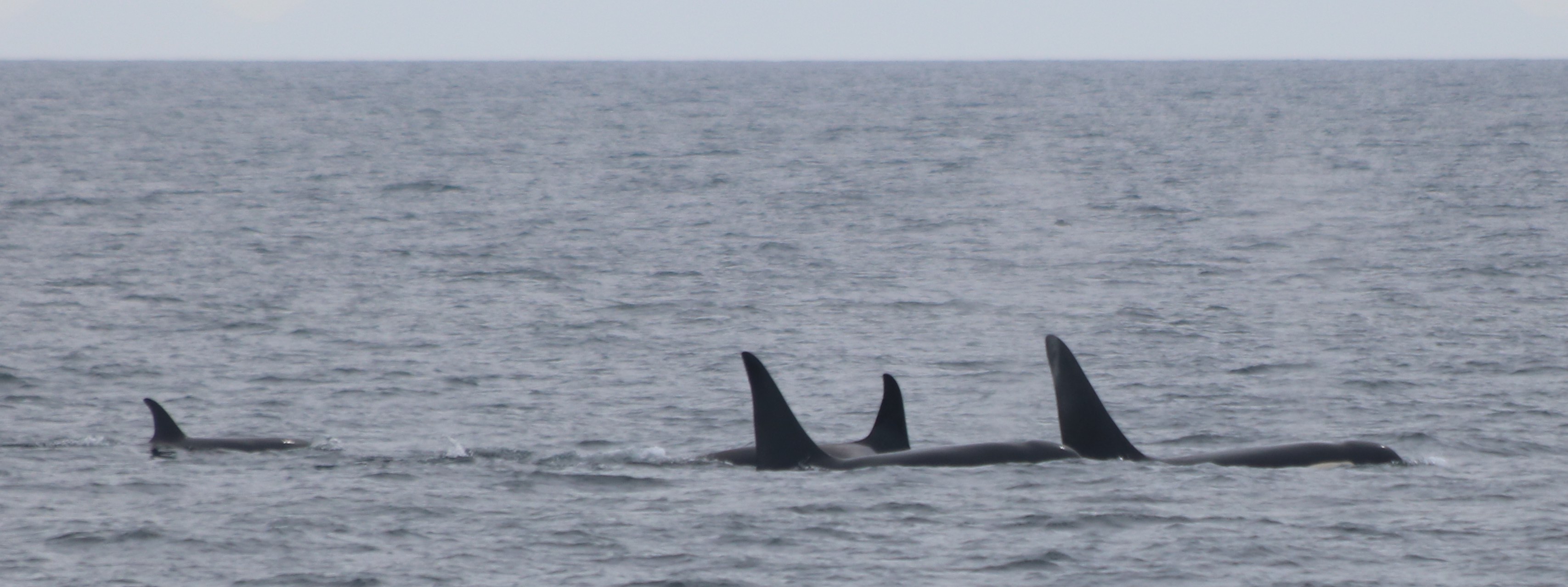
Things are looking up. We recovered all 39 instruments without a hitch (see "fill the decks"), and the data quality is good. A couple of channels (out of
156) went noisy half way through the deployment. We will still get MT data from them, and one collected CSEM data before going bad, so
we've only lost a fraction of a percent of our data. That's not bad going.
To round out the last week, we deployed half the instruments in deep water on the incoming plate to collect MT data and see
what we can see at the base of the plate, where in Nicaragua we saw an electrical conductor associated with melting.
Then we deployed the other half to extend our deep-towed CSEM line into shallow water towards land. Too shallow to deep-tow,
but as I described before, with a slow leak we don't want to put SUESI down deep again this trip. But she's holding a partial
vacuum on deck, so we've put her a couple of meters down, less than another atmosphere, and are towing at the surface down the line.
Being close to land is always nice after being far out to sea for weeks. Cameras were bought out in abundance today, although we're not
that close and it is a bit hazy, in spite of lovely weather (for Alaska). There are a couple of big volcanos in the distance, Pavlov,
which is quite active, and Pavlov Sister (pictured below). Pavlov was in the clouds, but Sister was not, and presents a very nice
profile. (Later this evening they both appeared from the clouds before sunset.) I tried to get a picture of SUESI being launched with
volcanos in the background, but it was indeed too hazy, so I settled
for some closer islands. And although we've seen a lot of humpback (?) whales, today we saw a nice pod of orcas. That was
a treat.
Pavlof Sister Volcano,

Pavlof and Sister Volcano,
.jpg)
Fill the decks...
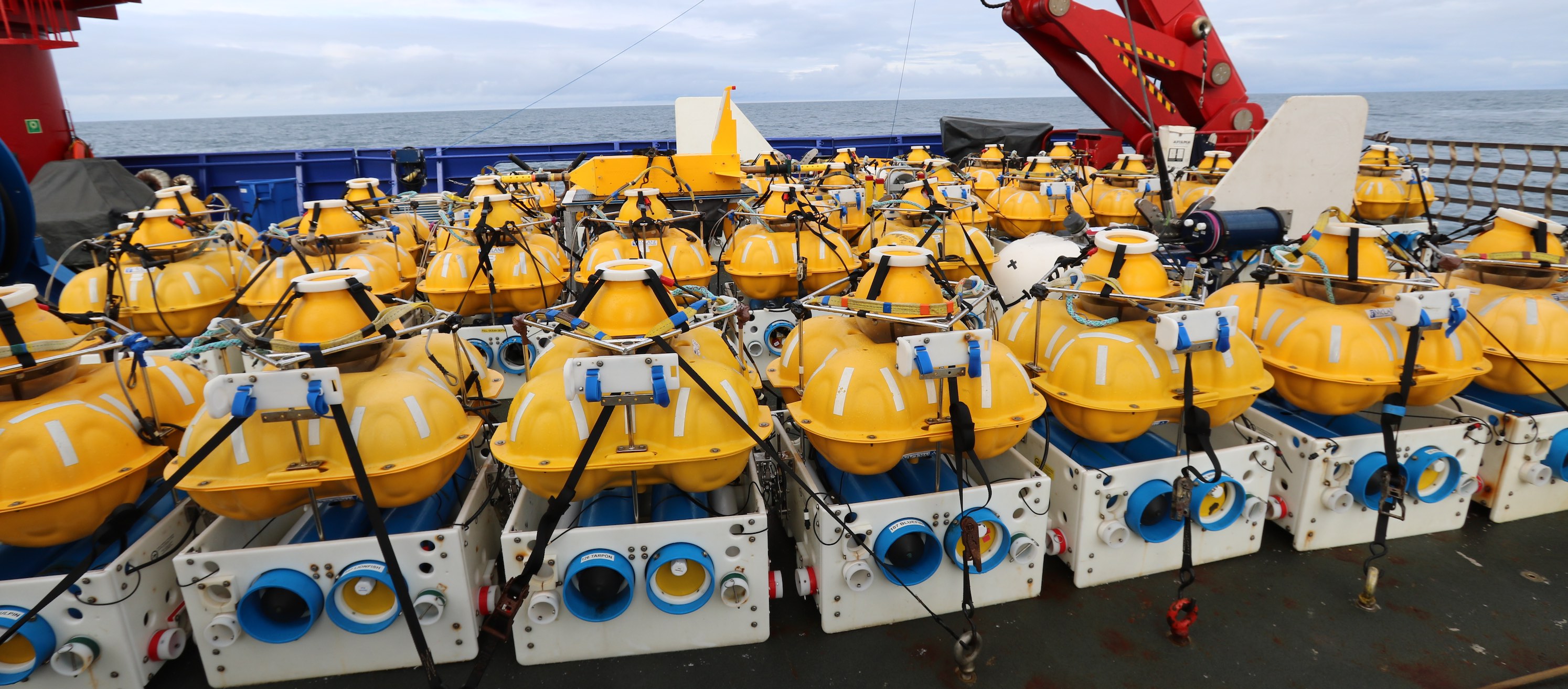
Friday June 14.

Dear Reader,
Much has happened to your correspondent since he last posted, having just got SUESI running after a blown transformer. Fixing
problems has become a game of whack-a-mole. So I will start with a harmless photo of whales (not to be confused
with the Prince of Wales), taken again by Samer. We've had whales around
the ship on and off the whole trip.
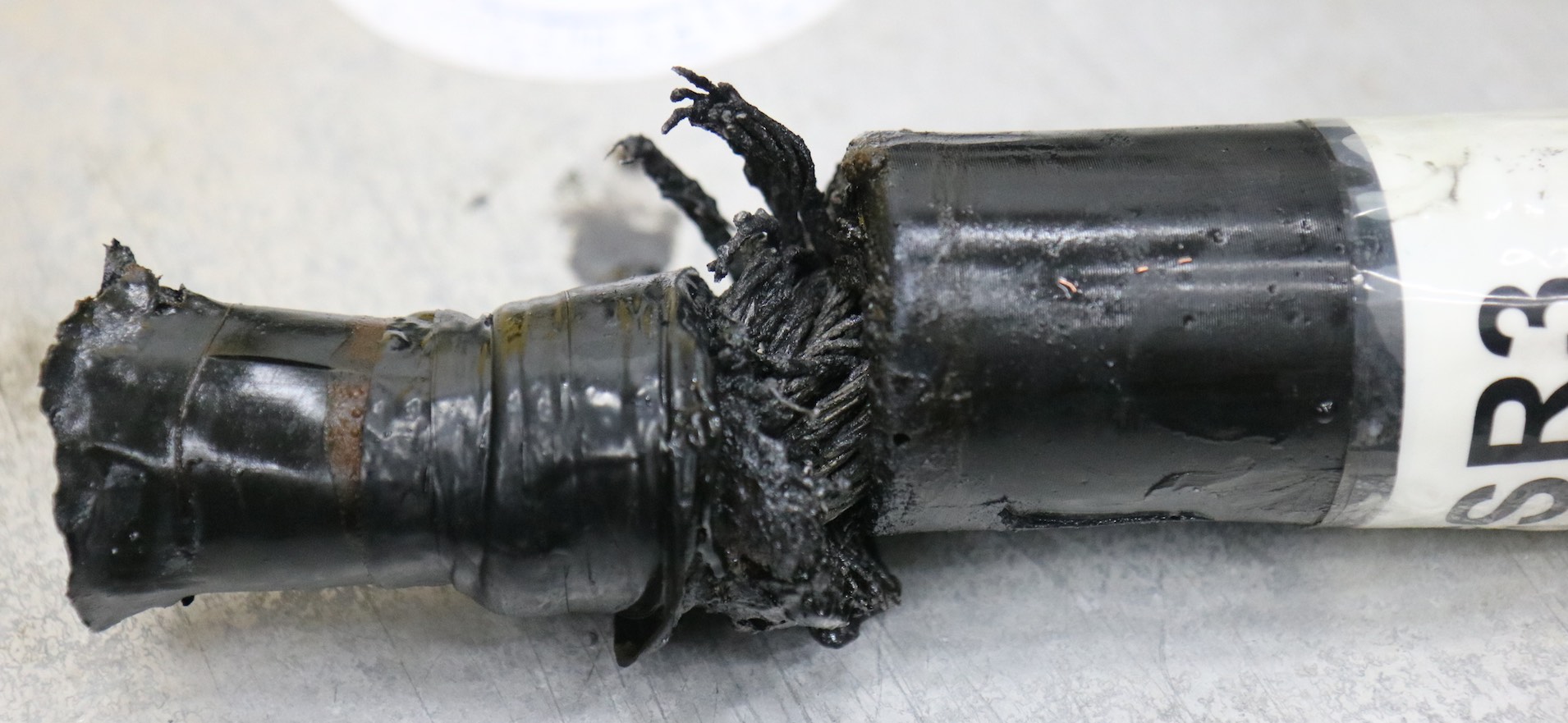
After the SUESI recovery last Friday we picked up all the instruments again, which is a several day process, and deployed them again, another
day's work. That took us to the 11th, when we started our third tow with SUESI. I was just thinking about going to bed when the output
current on SUESI went up and down from 250 to about 10 amps, the usual sign of a broken electrode. We pulled her in and discovered
that we had burnt up the termination on the short antenna/electrode assembly. We think the termination between the antenna and the
connectors we plug into SUESI had developed a little resistance. It doesn't take much resistance to create a lot of heat when you're
pushing 250 amps through a cable, and once you melt the insulation to seawater it goes downhill, and very messy/stinky, quickly. Fortunately,
we have spare terminations and it was a quick fix to get SUESI back in the water, although this took us until about 3 am and I'd been up
since before breakfast.
Time to have another look at the whale photo.
Things went well until yesterday afternoon, when we noticed a new message in the SUESI data stream:
!- WARNING *** LEAK DETECTED ***
You would be right to think that this was not good news. We were able to cancel the warning, and it only came back every now and then,
so I clung to the hope that it was a false alarm and we kept towing. I did some yoga and went to bed. Foolish me.
I was immediately woken by the phone. Phoning me in the night with a SUESI problem has become a bit of a joke in the lab, immortalized
in a video the students made some years ago (see "SUESI Guide" in the SERPENT blog). Anyway, now the problem was reported as "something went bang and communication with SUESI
stopped". Also not good news. We started pulling SUESI in and I poked around and decided that the problem was with the topside crossover
network that separates the high frequency communication signals from the 2,000 VAC power that we transmit down to SUESI over the tow
cable. I had a solution, which was to swap the good transformer from the power supply with the bad crossover network for the bad
transformer in the power supply in which presumably everything else still worked. This was not something I wanted to do in real time,
so we bought SUESI in and beached her, and then I went to bed around 3 am (again).


Time to have another look at the whale photo, but if you're really interested the blown transformer is on the left, with the black
gash, and on the right is the working transformer installed in its place.
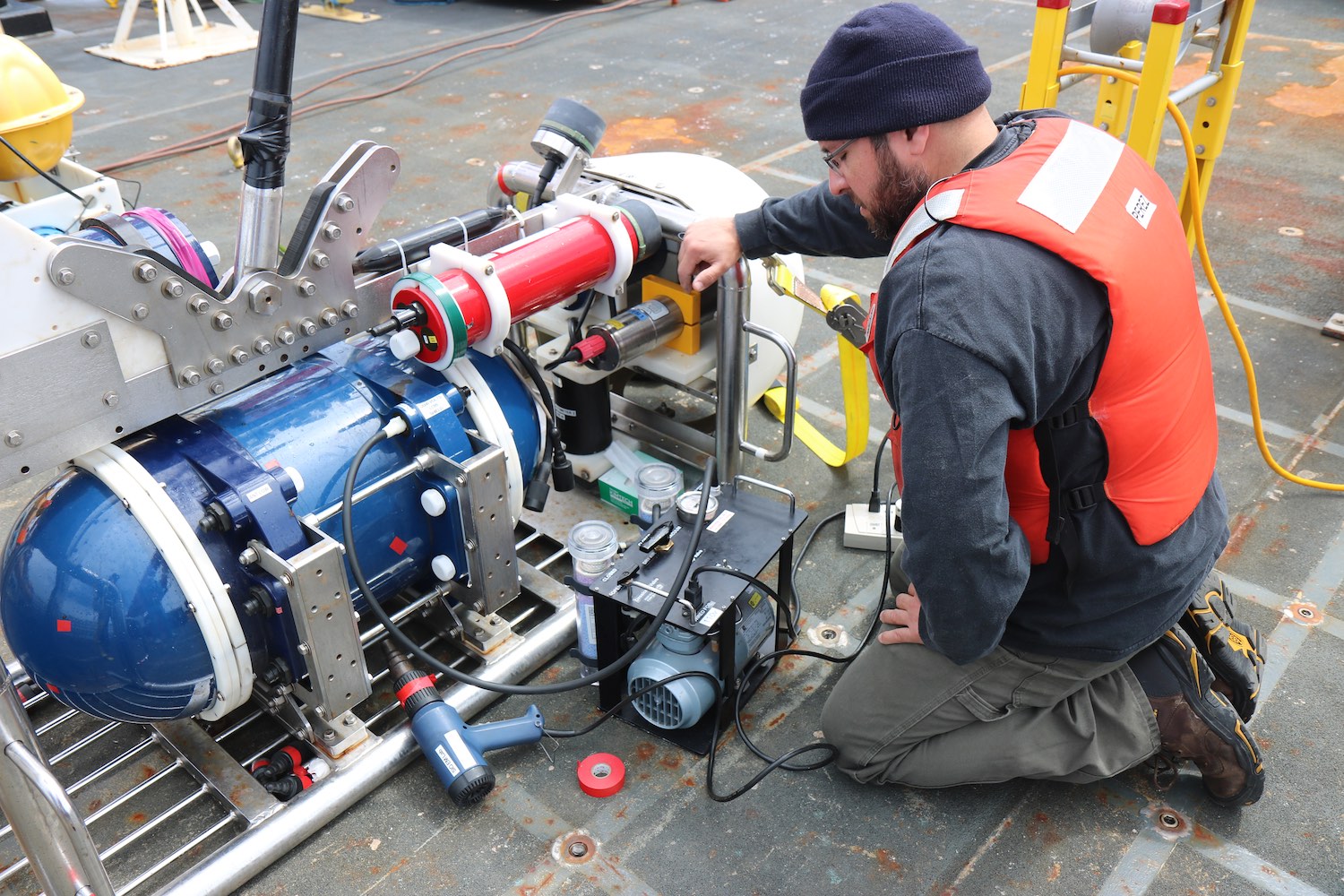
I got up for lunch, then set about doing the transformer transplant. This went well and worked, and we were soon talking to SUESI
on deck just fine. Except for !- WARNING *** LEAK DETECTED ** This time we couldn't cancel it, which rather suggested we really did
have a leak, although it had to be small since everything else was working. We set up an operation on deck where we pulled dry air through SUESI using a vacuum pump, while heating her belly with a
heat gun to help evaporate any water. This worked, and we had no more warnings, confirming once again that we had a high pressure, very slow leak.
But we can't count on it not getting worse, so reluctantly decided that we can't send her to depth again this trip.
I haven't reported this in the blog, but we were already working with the spare SUESI, having seen some nasty corrosion on the
first one after the second tow. I went back to the first one and investigated some more, and discovered that she too had a small
leak. It seems that these two instruments, which have worked very well for over a decade, need some servicing. We don't normally
pull o-ring seals apart gratuitously because they normally work well undisturbed, but maybe it's time. Meanwhile, we've collected a LOT
of good data this trip, and have a few more things we can do with what remains of our gear, which includes 39 working seafloor instruments.
Maybe it's time for another sunrise photo:
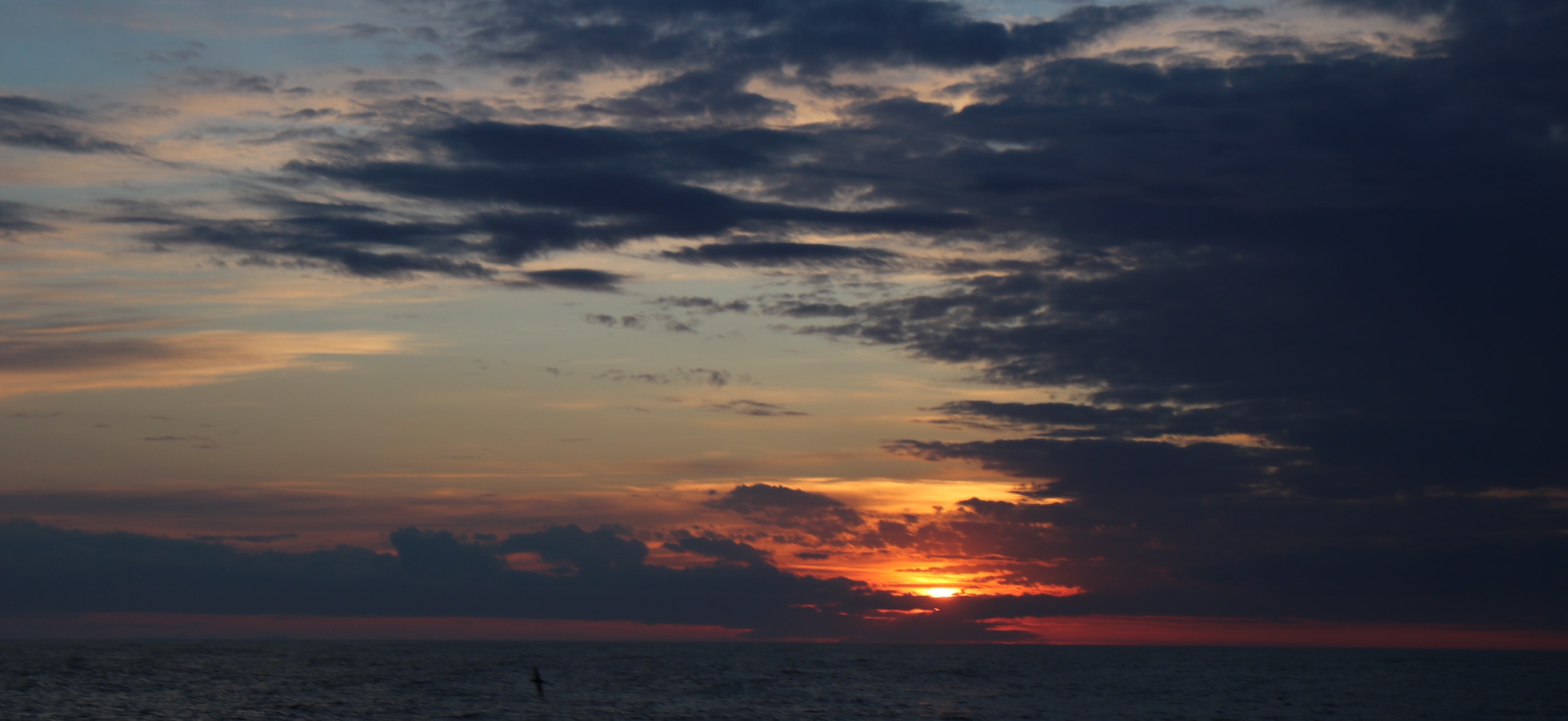
Sunday June 9.

Someone used my camera to take some nice sunrise pictures. I will provide attribution when I next talk to the night shift. (It
was Samer.)
Hauling in:

We continued our SUESI tow until Friday morning, and started hauling the array back in. I got up and in my usual fashion
headed for the current area of operations to check in - in this case the winch room on the 02 deck. Samer was re-booting the
SUESI monitoring software (SUESI-GUI) because he thought it had crashed. "How do we know SUESI hasn't crashed?" I asked - another hunch.
I guess there's an advantage to being old and, perhaps not wise, but at least experienced. And maybe old enough to know that
there's more to life than software. I went down to the lab and indeed the
topside power supply (the Elgar) showed 0V. You may recall that this was our #2 unit, the #1 unit having been unable to deliver full power
without crackling,
but in the meantime I had replaced the likely bad components in the #1 unit, so I switched SUESI back to #1 and everything worked fine.
We finished the recovery in an orderly fashion. Later I worked out that the 120/2000V step-up transformer had shorted, after 2,000 hours of use.
The #1 unit only has 1,000 hours on it, so I'm not too worried (right now).
Little things that work:

The big, black antenna cable is a special order item, with a large aluminum conductor, aluminum being a LOT lighter than copper, with a floating
plastic jacket, so the whole thing is neutrally buoyant. It is buoyant at the surface, but under pressure it tends to get squeezed and sink a little below
SUESI, so we need to add a little extra floatation. We had been taping on blocks of "syntactic foam", a mixture of epoxy resin and micro-spheres
of glass, but this is cumbersome. A new trick we are trying this trip is to just clip in small glass floats, which are more buoyant than
the foam, and it has worked well. You might notice the white plastic funnel attached to the end of the copper electrode. This is another
trick that I worked out with my colleague Peter Kowalczyk in Japan during a hydrate study. Pushing hundreds of amps into the seawater
ablates the copper - you see lovely patterns from preferential etching around the crystal structure (see picture - a cottage industry
in copper jewelry has developed on this cruise):

What we've noticed for a while is that if there is any obstruction to current flow, such as tape around the copper (as was the case in
the picture), you get extra
ablation at the edges. This includes the point where the copper electrode is attached to the antenna, and this is bad because extra
erosion here can result in the electrode breaking off entirely. Peter and I worked out that this was because the current could
flow back into the seawater around the insulating part of the antenna, without any competition from the rest of the electrode. Thus a bigger
current. We thwarted this by putting the insulating funnel around the electrode at the end, preventing the current from flowing back
towards the antenna. Works a treat.
Raised from the deep:

Sometimes the seafloor instruments come back with sea life. In shallow water this has included octopus, much to the
delight of the cooks on Italian and Japanese vessels. Not much on the seafloor instruments this cruise, but thanks to Samer's deep-towing
skills, the Vulcan system scraped the bottom going over a ridge. We brought back a bit of mud, and this sponge/coral (I'm no biologist).
If there's a biologist out there who wants it, it is in the -80C freezer on the Sikuliaq.
Wednesday June 5.
Screen shot of maximum wire out - SUESI is the yellow triangle.

Continued our SUESI tow along the second line across the trench. The weather is now very good, so we're not having any trouble
with tension, and this evening we reached the trench and were able to deploy all the wire we are allowed to deploy, 7,600 m. There is
much more wire on the winch drum, but there's a broken piece of armor on the cable somewhere deeper, and it would be a bad day if
we tried to pull that through the traction winch, so we are stopping a safe distance before it. SUESI briefly reached a depth of 5,100 m,
exceeding the record of 5,000 m set on SERPENT.
Tuesday June 4.
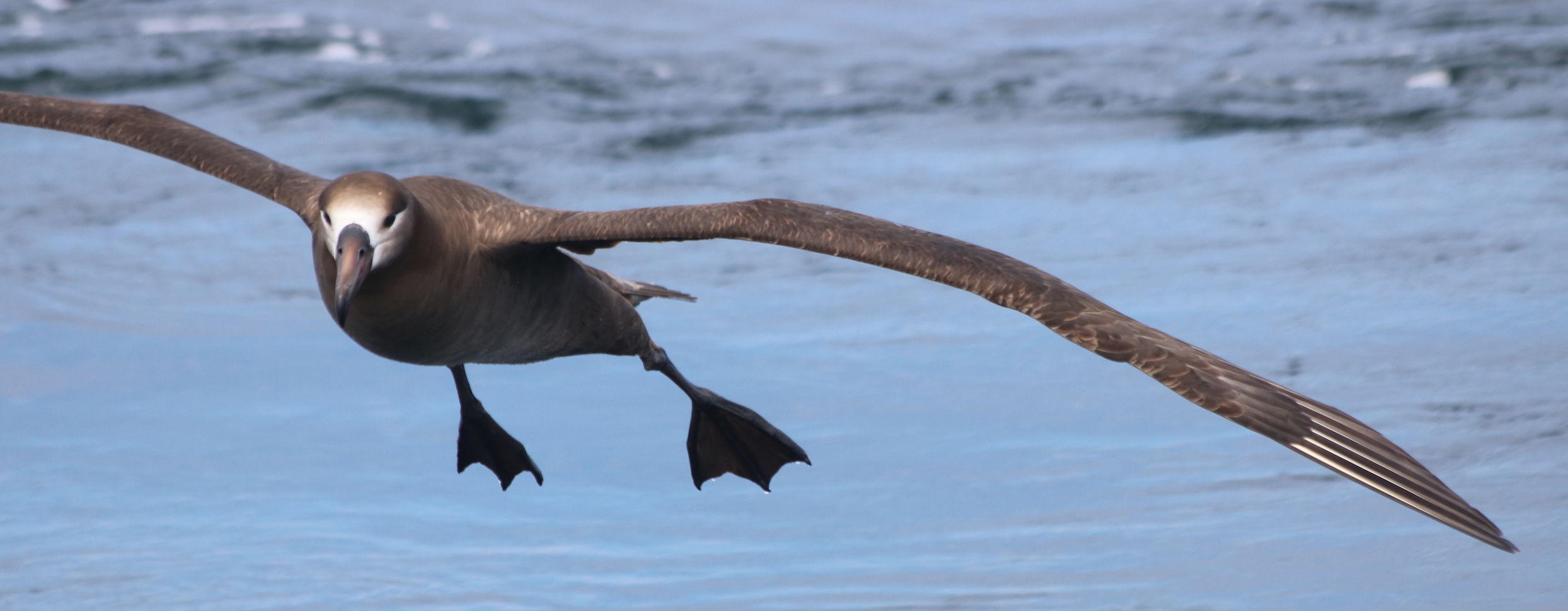
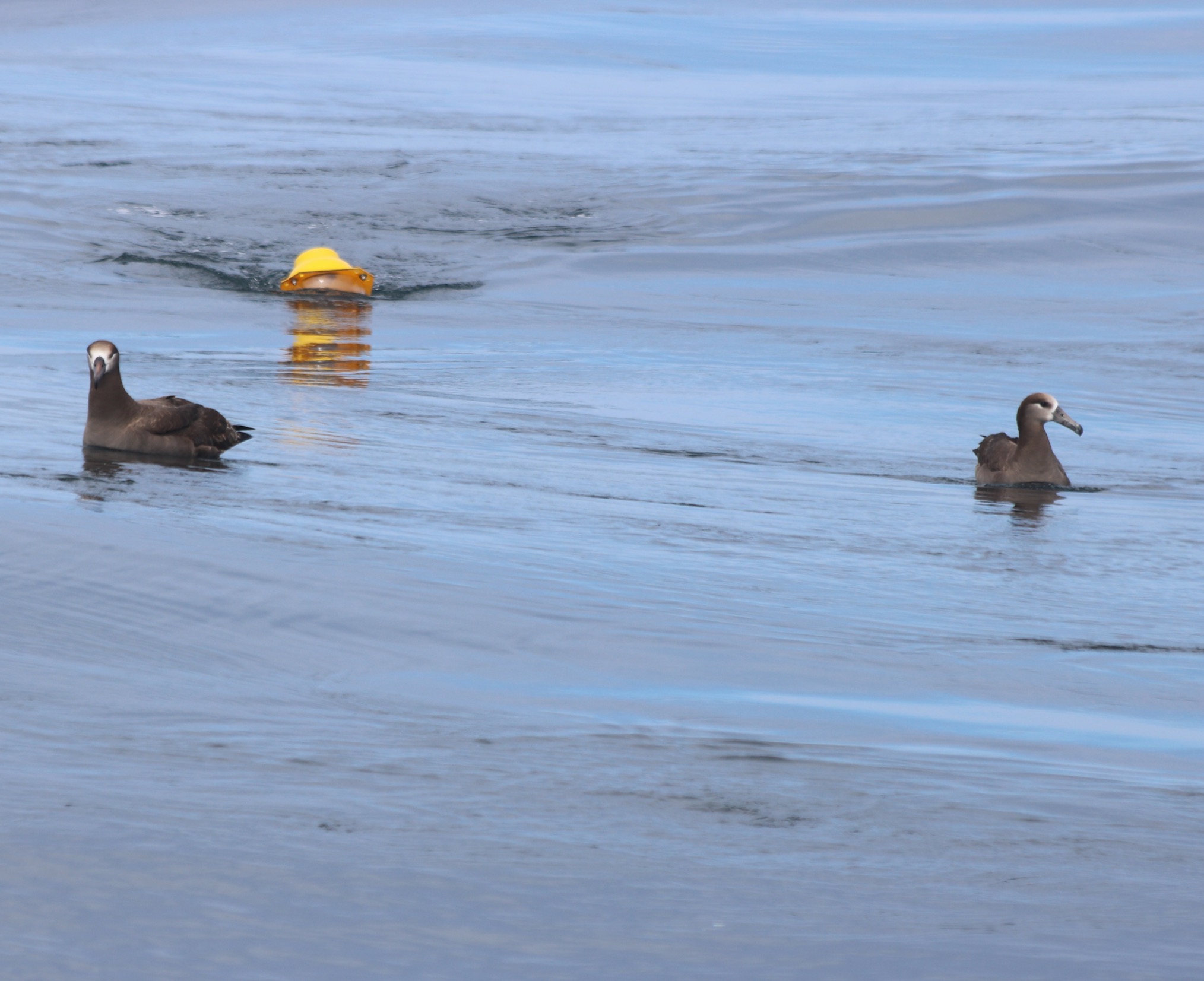
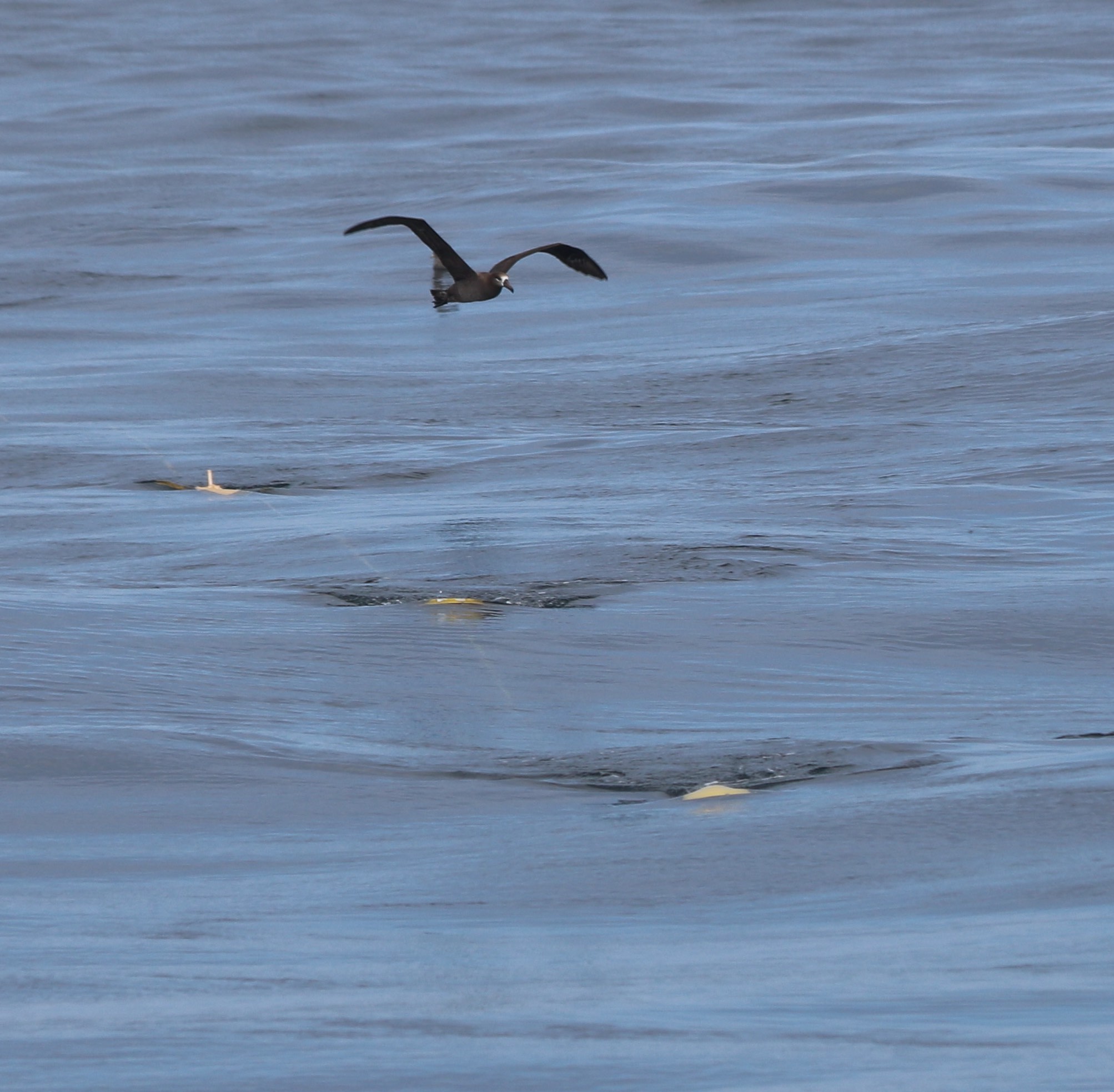
It took until the wee hours of the 3rd before we had all instruments recovered. Well, not quite all. We have one stuck
on the seafloor, talking to us occasionally but not releasing. Might be an electrical fault in the acoustics, might be stuck in
the rocks. These things happen occasionally. I budget for a long term loss rate of 1%, and we didn't lose any on the last cruise,
so we're doing OK so far. After recoveries we had a 14 hour transit to the next line, which gave everyone a bit of a break.
I did some laundry. We
started deploying at dinner time yesterday, and had all 39 instruments in the water by lunchtime today. 28 minutes per instrument. That's not
bad, and was limited by the transits between sites.
After lunch we started to launch SUESI for the second time. Having ironed out the bugs, she was in the water within two hours.
We are starting our tows at the shallow ends of the lines, closer to the coast, so we see a little more bird life. Birds always seem
to be attracted to instruments. Back in the dark ages when I was first working with Chip Cox, we'd sometimes have to chase lost instruments for
a day or more (no nifty stray lines in those days). Chip would look for birds hovering around and head for them. Today we had a fine pair of albatross checking out the
Vulcan and antenna floats.
Saturday/Sunday June 1/2.
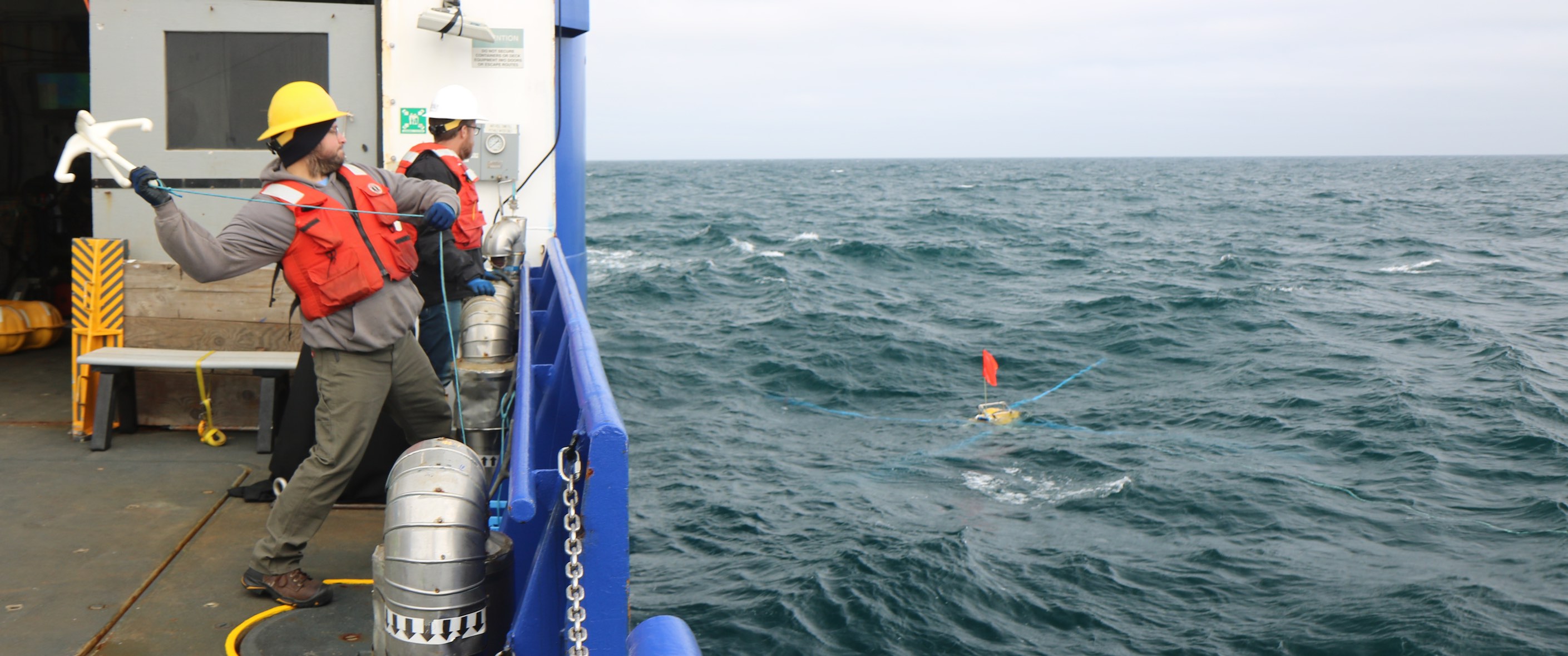

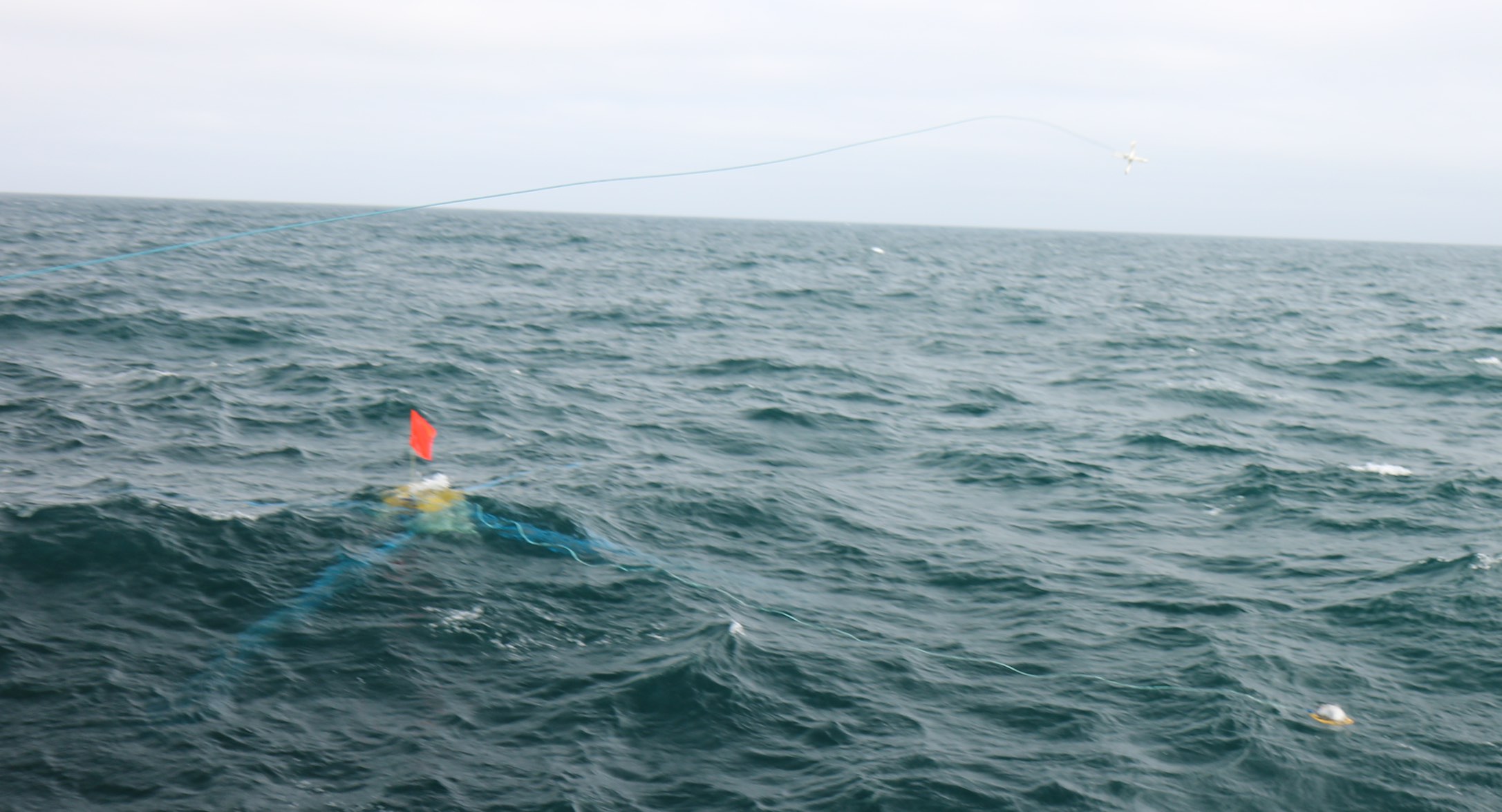
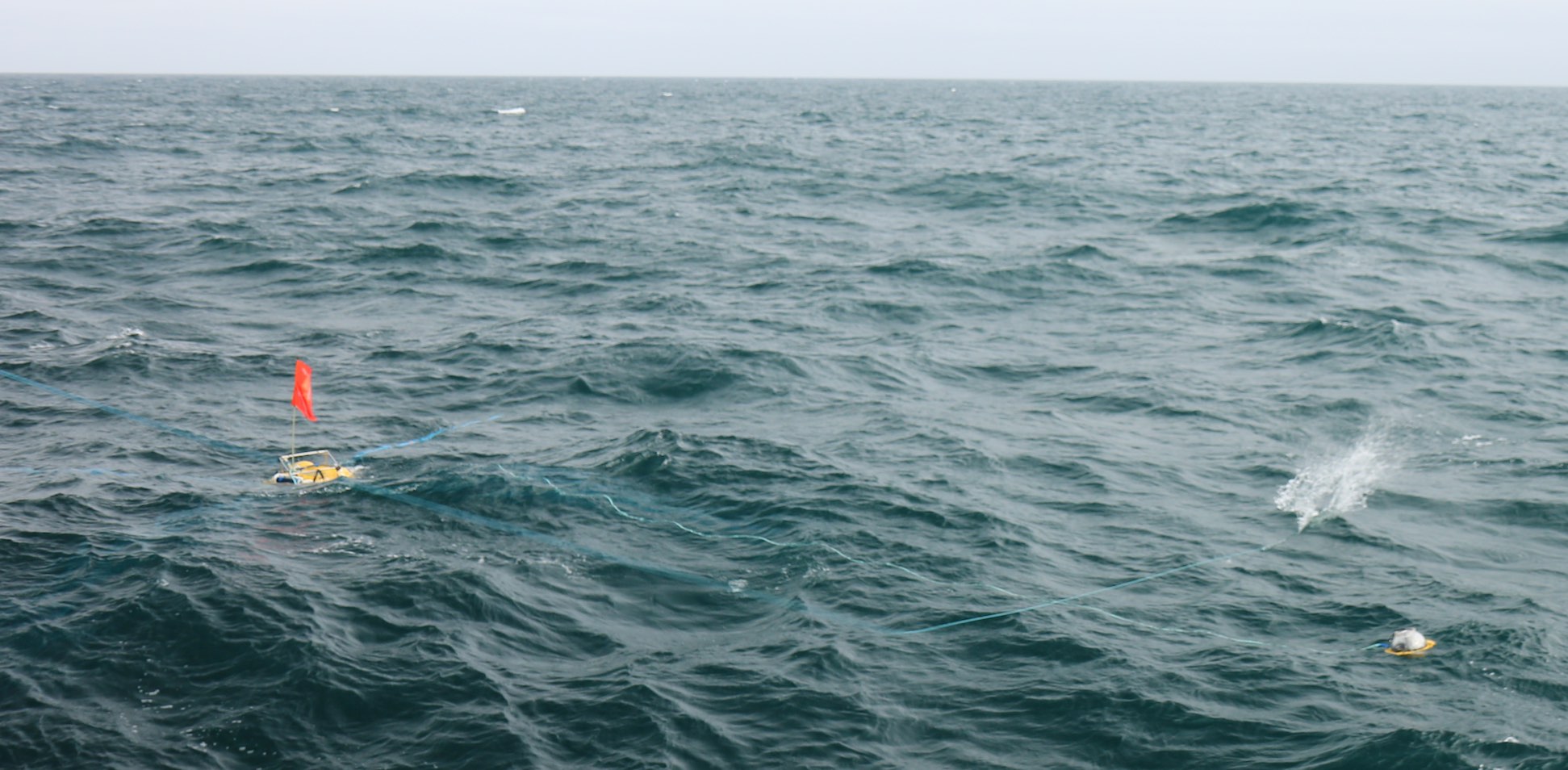
We continue with the recoveries of this line of seafloor instruments, fortunately with no more dramatic incidents. It is deep water
(up to 5,500 meters), so with a rise rate of 20 meters per minute it takes nearly 5 hours for each recovery. That clearly won't do,
so our approach is to drive along the line releasing 4 or 5 instruments at about half hour intervals, the go back and pick them up.
This way we can average a recovery time of closer to one hour per site. We have a nifty
"stray-line" float that is trapped on top of
the instrument by the anchor, but floats free on a tether of floating line when the instrument is released. On the surface the weight of
the batteries flips the float over and activates a flashing light (if it's dark) and a GPS/radio beacon. The instrument radios the ship
with its position. The floating rope then provides a nice target to grapnel the instrument and bring it back aboard the ship. These stray-lines
mean that we can play a little loose and fast with the recoveries, since it is easy to chase down floating instruments.
Tools of the trade:

Tools of life support:

When Cathy and I first came to the USA the coffee wasn't that good, and someone tipped us off about a coffee roaster in Berkeley called Peets.
Cathy and I had a standing order with Peets to FedEx two pounds of French Roast beans to our house every couple of weeks. The coffee on the
research ships was especially not good, so I took to taking my own coffee maker and big bushels of beans. Peets French Roast, of course.
Then on the East Pacific Rise cruise in 2004 it expanded to an espresso maker. This all worked rather well for many years, until recently. The
US coffee scene has come a long way, and there's a lot more than Peets to be had (although ship's coffee is still pretty grim).
Word got to me that on the last EM lab cruise (which I wasn't on), some of the science party were throwing away the Peets coffee to
make pots with their own beans. This horrified me. Now, I won't go so far as to say that their own beans were rubbish - I wasn't there, and
I'm sure they were very good, if you like that sort of thing. But I'm sure I don't, not after drinking only Peets for 35 years.
Chris and Jake decided that to avoid a nasty scene, they would bring two coffee makers (and the trusty espresso machine) on this trip. The
escalation continues...
Friday May 31.
Two instruments very much worse for the wear:
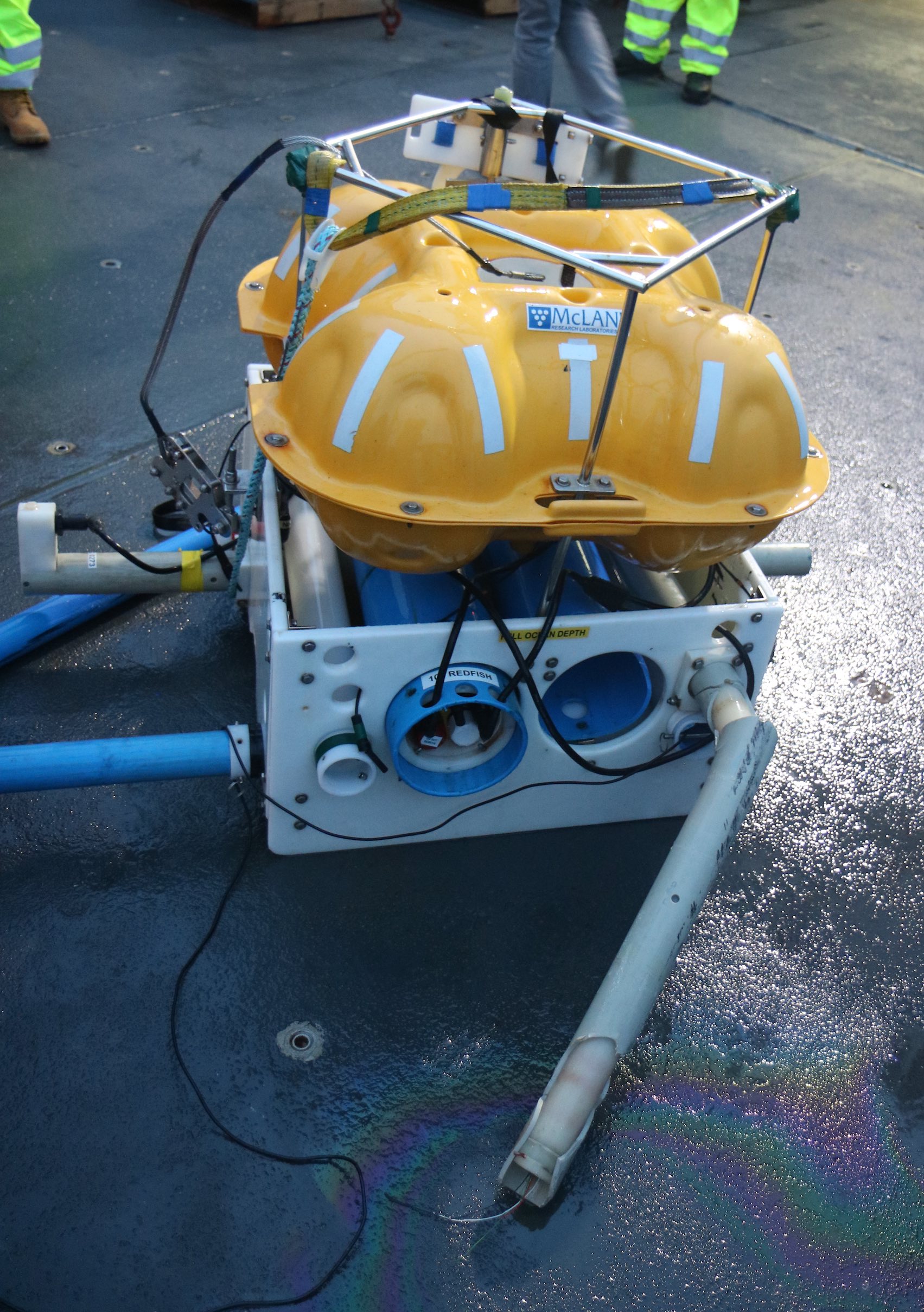 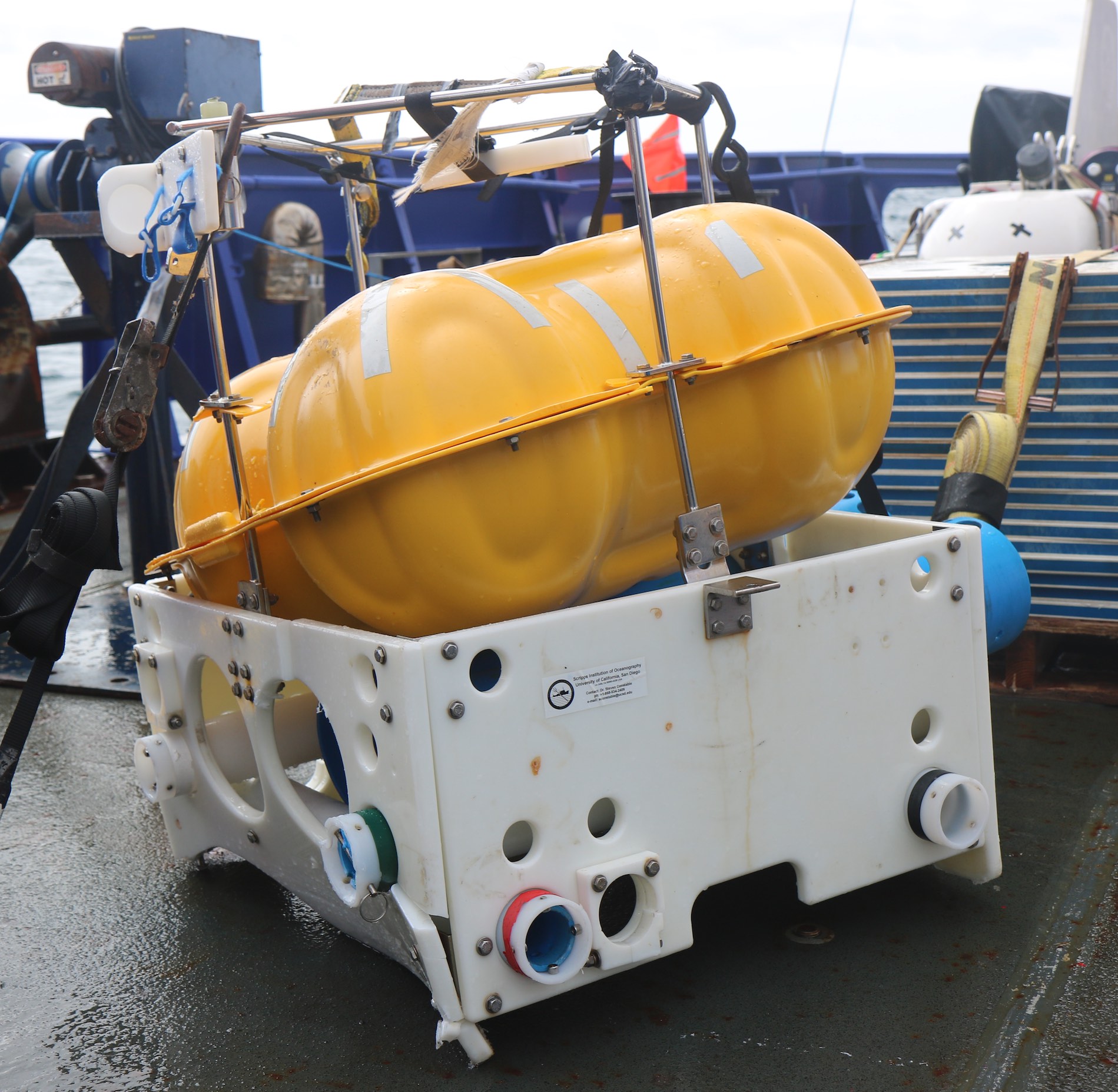
There are good days, and bad days. This was not a good day ...
I went down to the lab this morning and the first thing I noticed was the annotation "RIP" next to the names of
a couple of instruments on our master recovery list. I asked Kerry if they had failed to release. "Oh
no, it's far worse than that. It's carnage." What could possibly be worse than losing instruments on the seafloor? It turned out to
be losing instruments on the surface by running over them with the ship's thrusters. This has only happened to me once before,
off NW India on a very rusty Russian vessel called the R.V. Akademik Boris Petrov, in what is known in the lab as the "Fruitbat smoothie" incident.
"The bad news is that bits of your instrument got stuck in the propellor when we ran over it, and we're drifting. The good news is that we are drifting away
from Pakistan."
Fortunately, the ship didn't do a complete smoothie job, and bits of the instruments hung together, including the data loggers,
which were badly damaged but recovered. So we got data from the sites ("Always look on the bright side of life, whee whoo ...").
But we are down two instruments which we had planned to deploy three more
times, and having two out of the first six recoveries end this way was not an encouraging statistic to say the least.
One does need to remember that bringing a 4,000 ton ship up alongside a drifting instrument is no mean feat, but it can be
done, and I've seen it done maybe a thousand times or more. Perhaps I shouldn't take it for granted...
Another bright side is that Kerry is no longer whinging about minor issues of data quality.
Thursday May 30.
Bringing SUESI aboard after the first deployment:
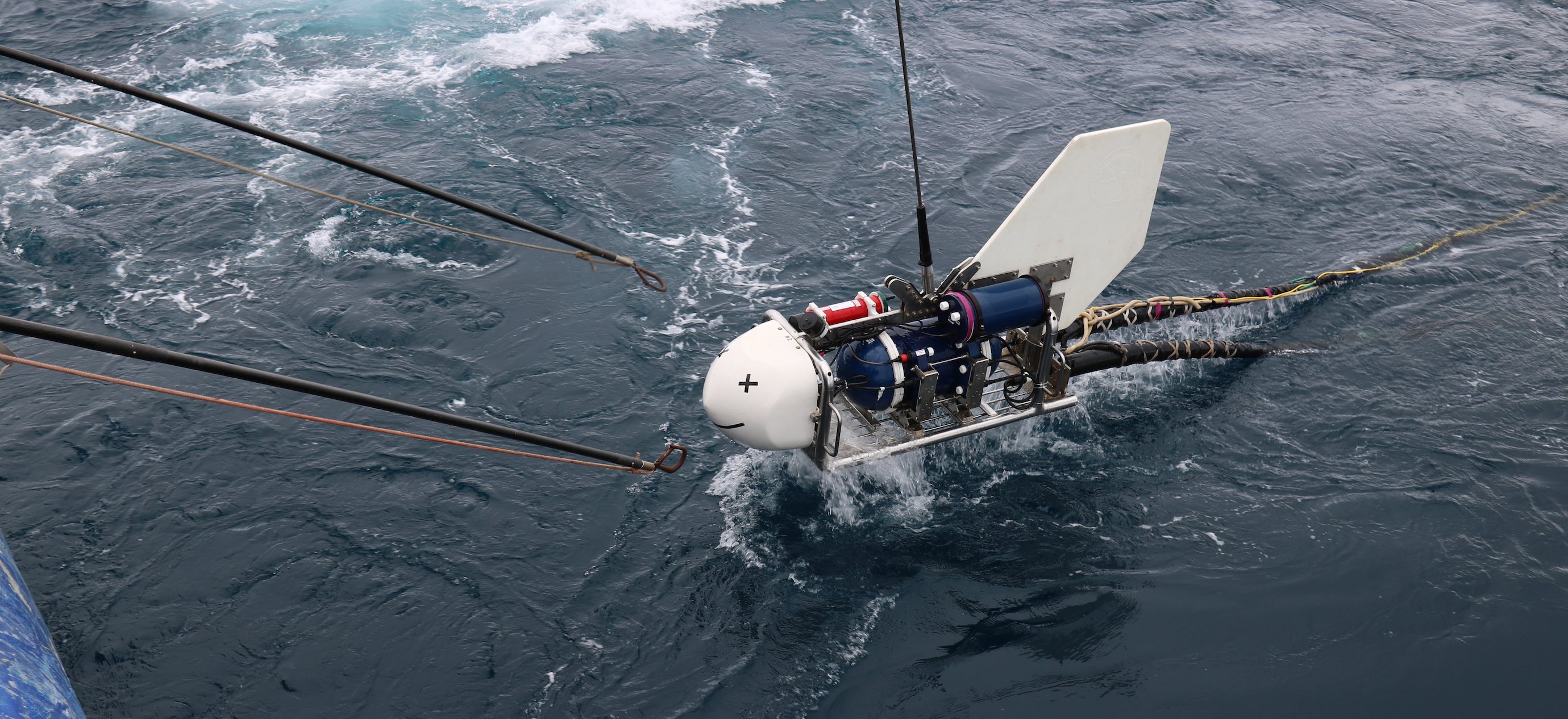
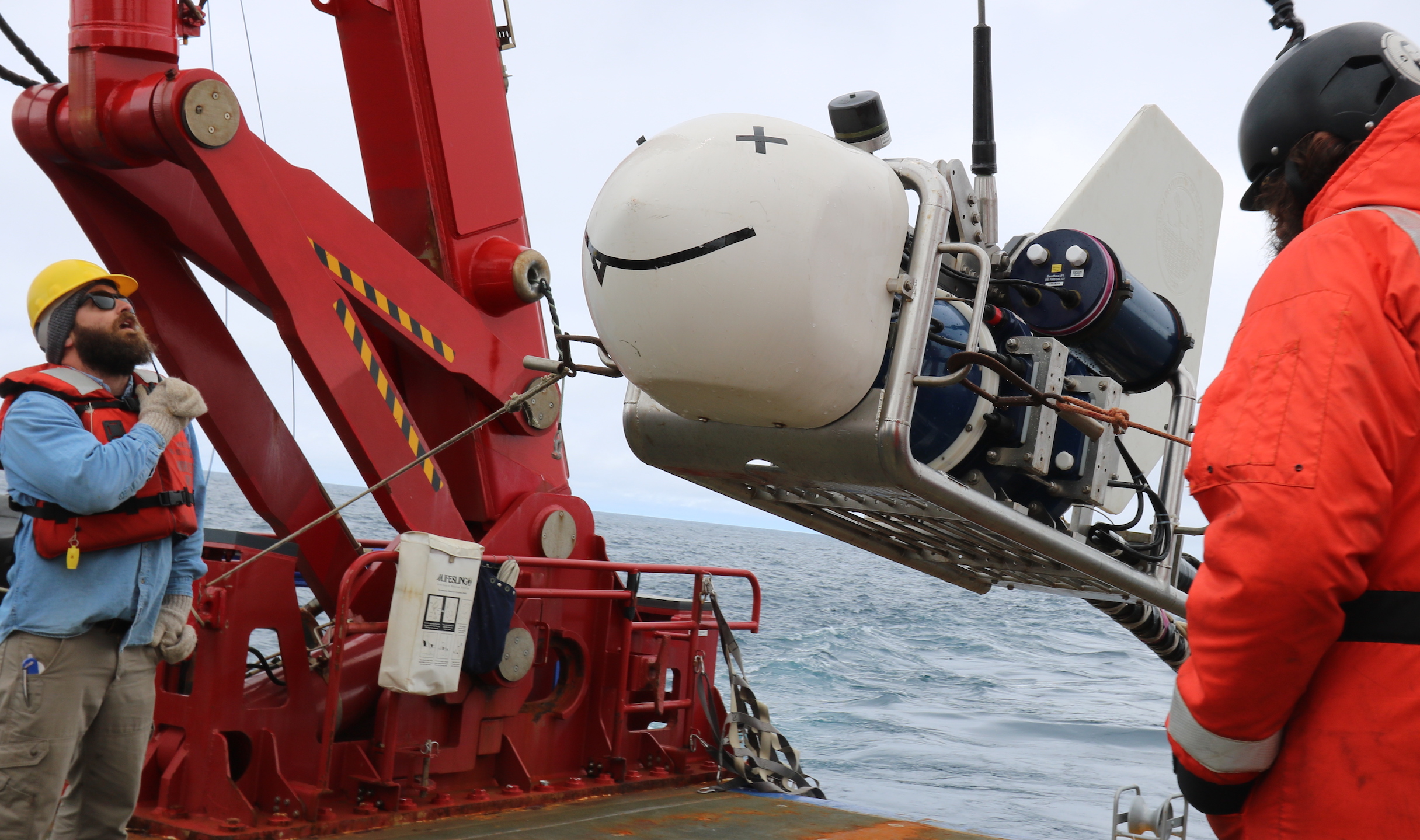
We finished towing the first line this morning and started to haul SUESI and the array
in. It take some time to bring in 7,000 meters of cable at 30 meters per minute, and it was lunchtime before SUESI was beached on
deck. Things moved pretty rapidly after that. We tested the first power supply, the one we thought failed, while the antenna was still
in the water, and confirmed that it did indeed go crackly at about 1,800 V. That done we pulled the 300 m antenna and the 500 m Vulcan
tow cable in, taking only a little over an hour to do so (a record?). After having squared away the deck we headed to the end of the
receiver line to start recovering the seafloor instruments. After a few hiccups with our acoustic units (bad connectors - it's always
the cables), we started bringing instruments up. They float up at about 20 meters per minute, so it takes over 3 hours for them to get
to the surface. Since it takes less than an hour to drive the ship between stations, we release 3 instruments at one hour intervals
and then pick them up as they surface.
Wednesday May 29.
The (mostly empty) deck is very different from when we sailed out of Seward (see photo at the beginning of the blog). Only
the spare SUESI, an empty winch, and lots of anchors are left.
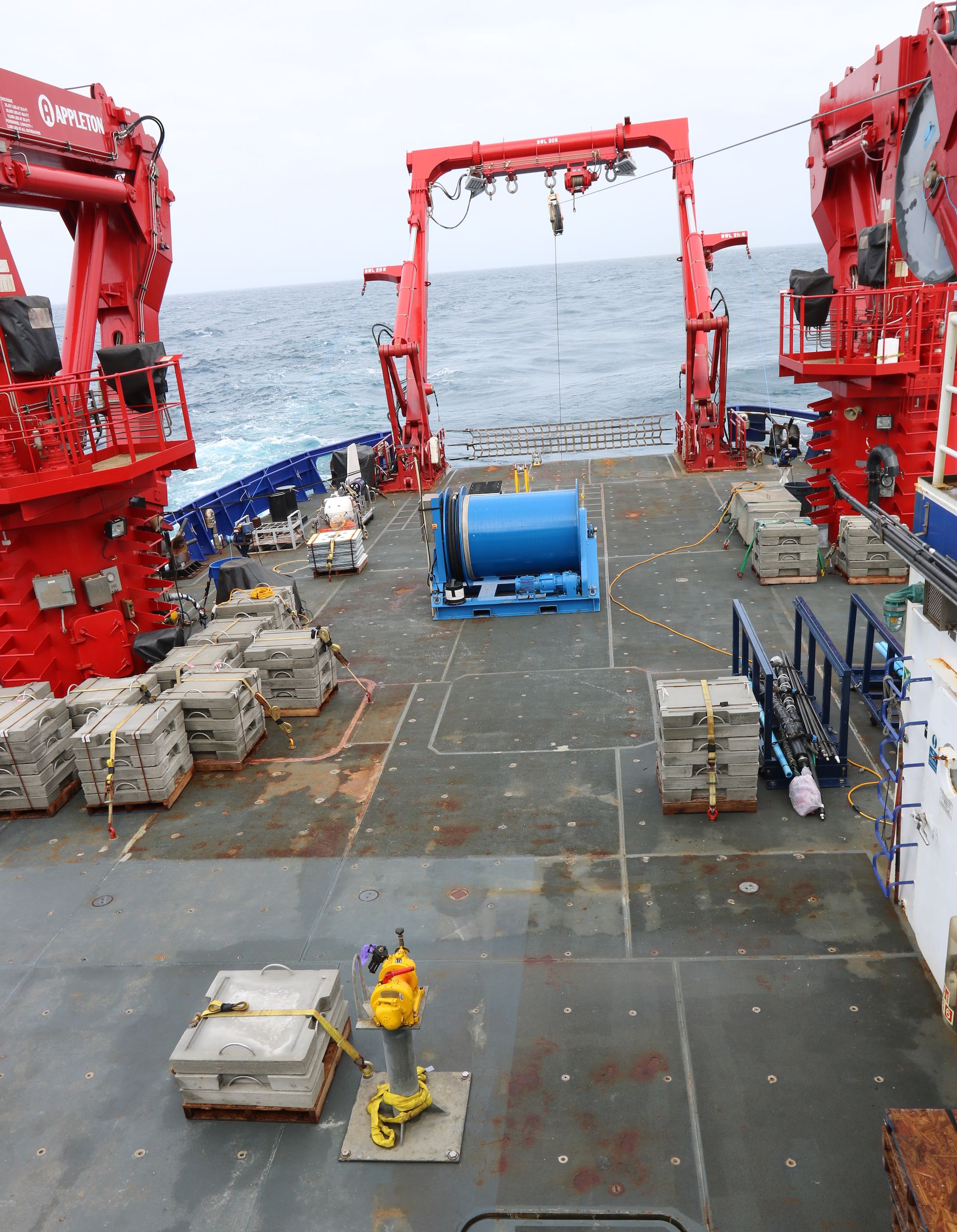
Got up this morning to find Chris trying to haul the deep tow cable in
without exceeding the tension limits as we steamed across the trench. He was going about 4 meters a minute, when 20-30 is normal. It was going
to take a long time to recover 7,000 m of cable at that speed, although of course as we made progress the weight of
the cable (nearly a ton per kilometer) would get less. I suggested speeding the ship up, which both dynamically takes
some weight off the cable and reduces the amount of ship heave that gets transferred, which helped quite a bit. We
got across the trench and started collecting data in 4,200 m of water on the other side.
Tuesday May 28.
Two shots of deck operations just before SUESI is deployed. SUESI has the smiling face and Vulcan is
the yellow instrument on the table. The big winch has the Vulcan tow cable and transmitter antenna.
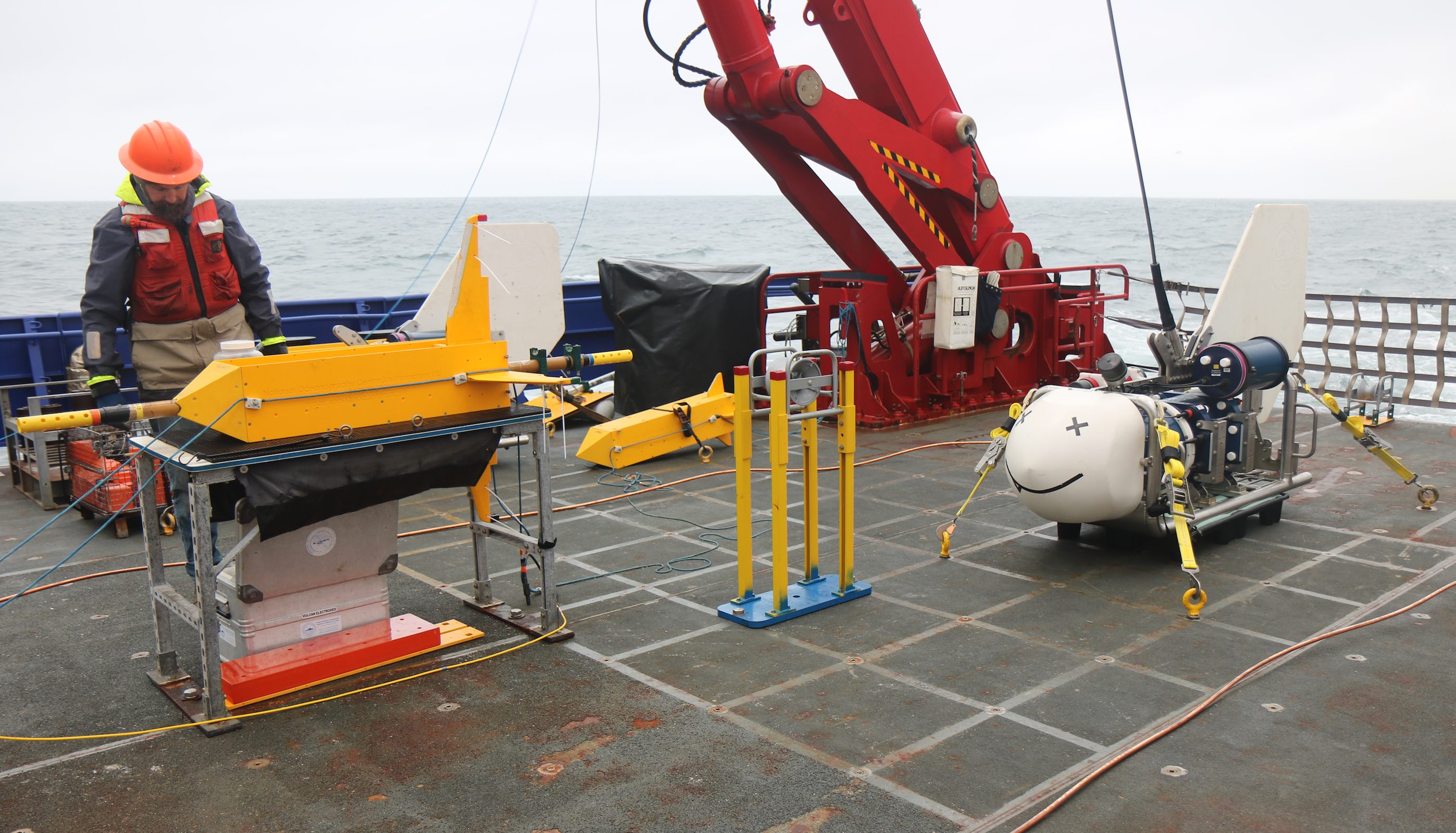
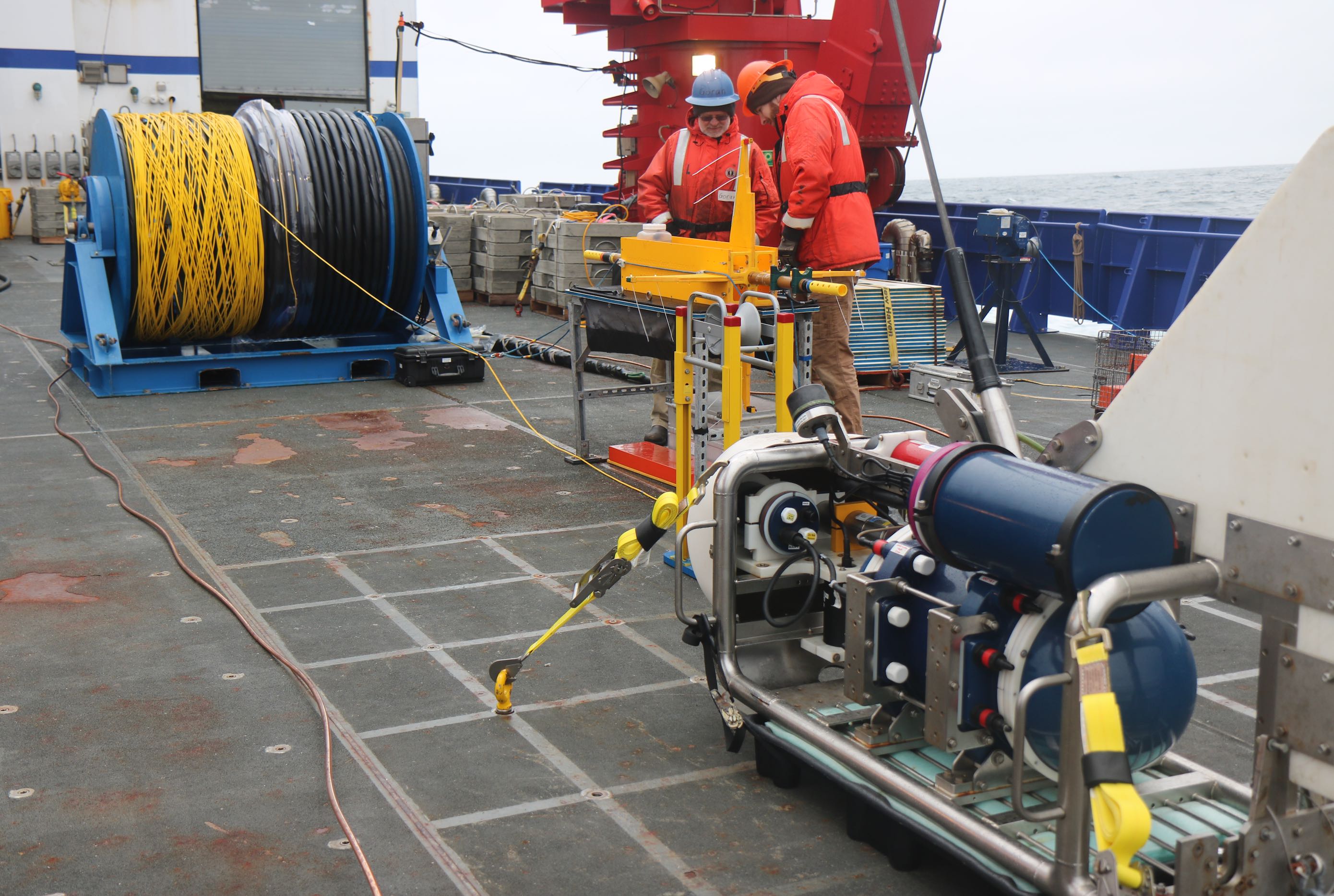
The last seafloor instrument was deployed at 5:30 in the morning.
Now we start to prepare SUESI (Scripps Undersea Electromagnetic Source Instrument) as we steam back down the line of
instruments towards the start of our transmitter tow. At about 9:30 we are starting to put gear in the water, first
our towed EM receiver (the "Vulcan"), then 500 m of tow cable, then the 300 m transmitter antenna, all connected to
smiling SUESI. Everything went very smoothly and tested just fine, and we put SUESI in the water just before lunch.
Then things went "pear shaped" as they say in the classics. We wound up the deep-tow cable voltage to 1,800 V, a
little less than our 2,000 V maximum, and the topside power supply made nasty noises and we lost communication with SUESI.
A very bad start, but we have a spare topside power supply. We moved all the cabling over to our second power supply
but we had no communication with SUESI, who is sitting a few hundred meters deep in the water by now. Had we killed SUESI
when the power supply crackled? The call was made to bring SUESI back on deck and test the gear using her spare twin. But I had a hunch,
and suggested we test the communications cable that goes from our control box to the power supply (which are in different labs).
This is a bit of a pain because the spare comms cable is shorter and we have to move everything closer to the power supply, but
joy of joys it works and we know SUESI is fine. We continue operations with the spare power supply and spare comms cable. Maybe
the first power supply is OK and it was the comms cable all along, but things are working now and we can test that later.
It has been a long day and I'm thinking about hitting my bunk when we start having concerns about the tension in the tow cable.
We are towing down the continental shelf into the trench, which is about 6 km deep. We know we can't get to the bottom of the trench,
but we were hoping to go to 5,200 m. However, the weather has picked up and the ship is pitching quite a lot, putting peak loads on the wire
close to the safe working load (14,300 pounds - don't ask me why cables are measured in meters of length and pounds of tension).
We are told that if we reach the working load the winch will free-wheel to protect the cable. Not what you want when your million
dollar instrument is just 100 meters above the seafloor. I discuss options with Samer and go to bed anyway.
Monday May 27. Deploying OBEM instruments one by one. We have 42 all up (a propitious number),
and it rapidly becomes routine. After the last instrument is deployed using the crane, a new concrete anchor is moved to the launch
area, then an instrument is lifted onto the anchor, and the crane is stowed. Magnetometer coils, electrode arms,
flag, and recording compass are all mounted. The recovery beacon/stray line and the acoustic release mechanism
(without which throwing instruments overboard is folly) are tested. We wait until the ship is at the next deployment
site, bring out the crane, and start the cycle again. This takes about 30 minutes for the closely spaced sites, and 50 minutes for the widely
spaced sites at the ends of the lines.
Monday Morning May 27.
First deployment:
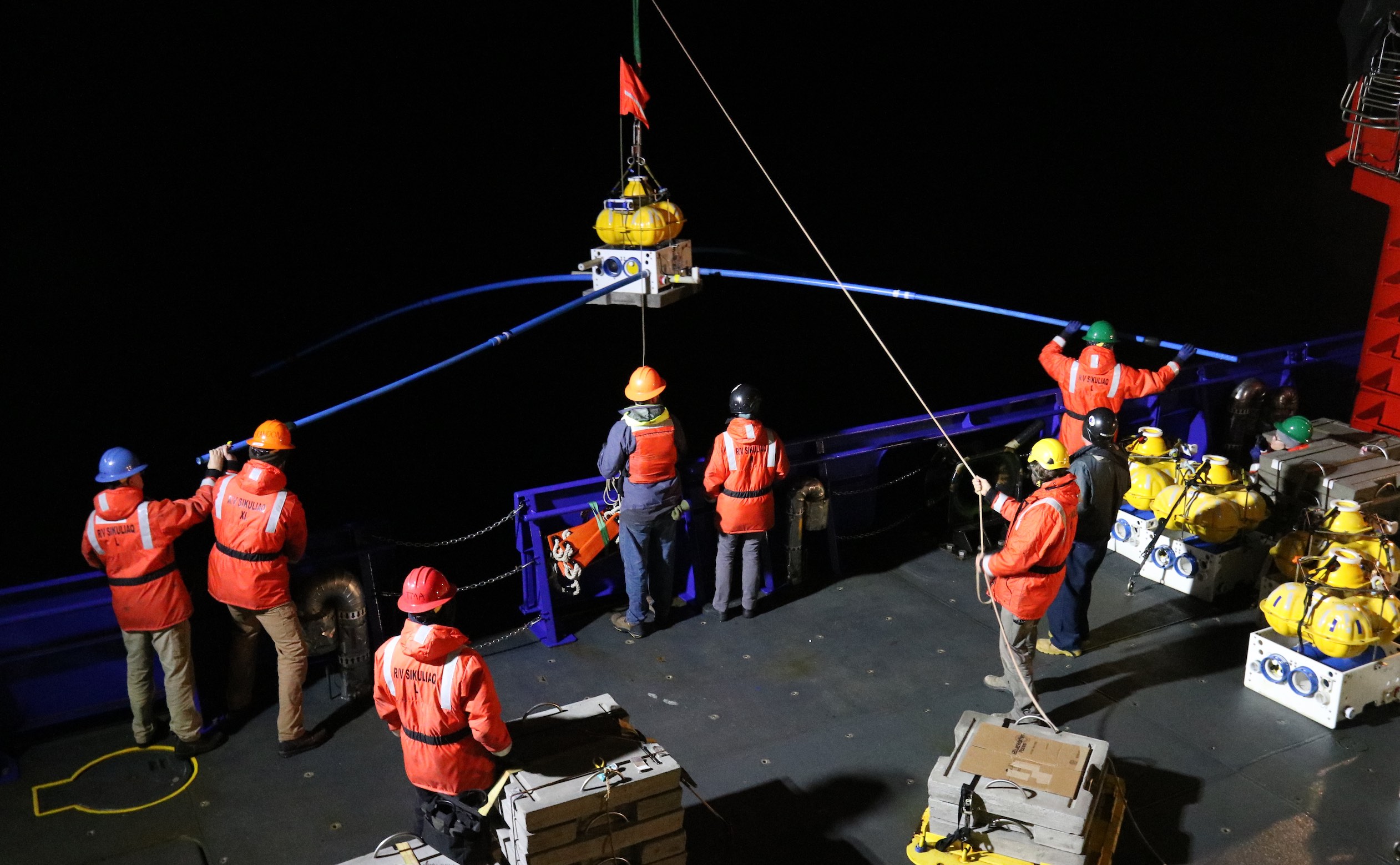
On station at 3:30 in the morning. We've had plenty of time to get everything
ready to go, and the first ocean-bottom (OBEM) instrument was all prepped for deployment as we arrived. Our enthusiastic night shift,
most of them doing this for the first time, was eager to see some action. With little fanfare or excitement (the way
it should be), we swung the first instrument over the side and let it go. Only 167 more to go!
Sunday May 26. Not much happening today, as we transit to station. People are getting their
sea legs and getting onto their shifts. We have always worked two shifts, noon-midnight and midnight-noon. With lots of enthusiastic
students aboard, we never seem to have trouble getting volunteers for the midnight to noon shift, and this cruise was no
exception. Weather has been up and down, but never too bad. The Sikuliaq has a reputation for rolling, but so
far so good. It helps that our transit has been mostly into the weather, so more pitching than rolling.
Saturday May 25.
Man overboard drill:
Launching the boat. ------------------ Speeding away. ---------------------- The "man" is saved.
 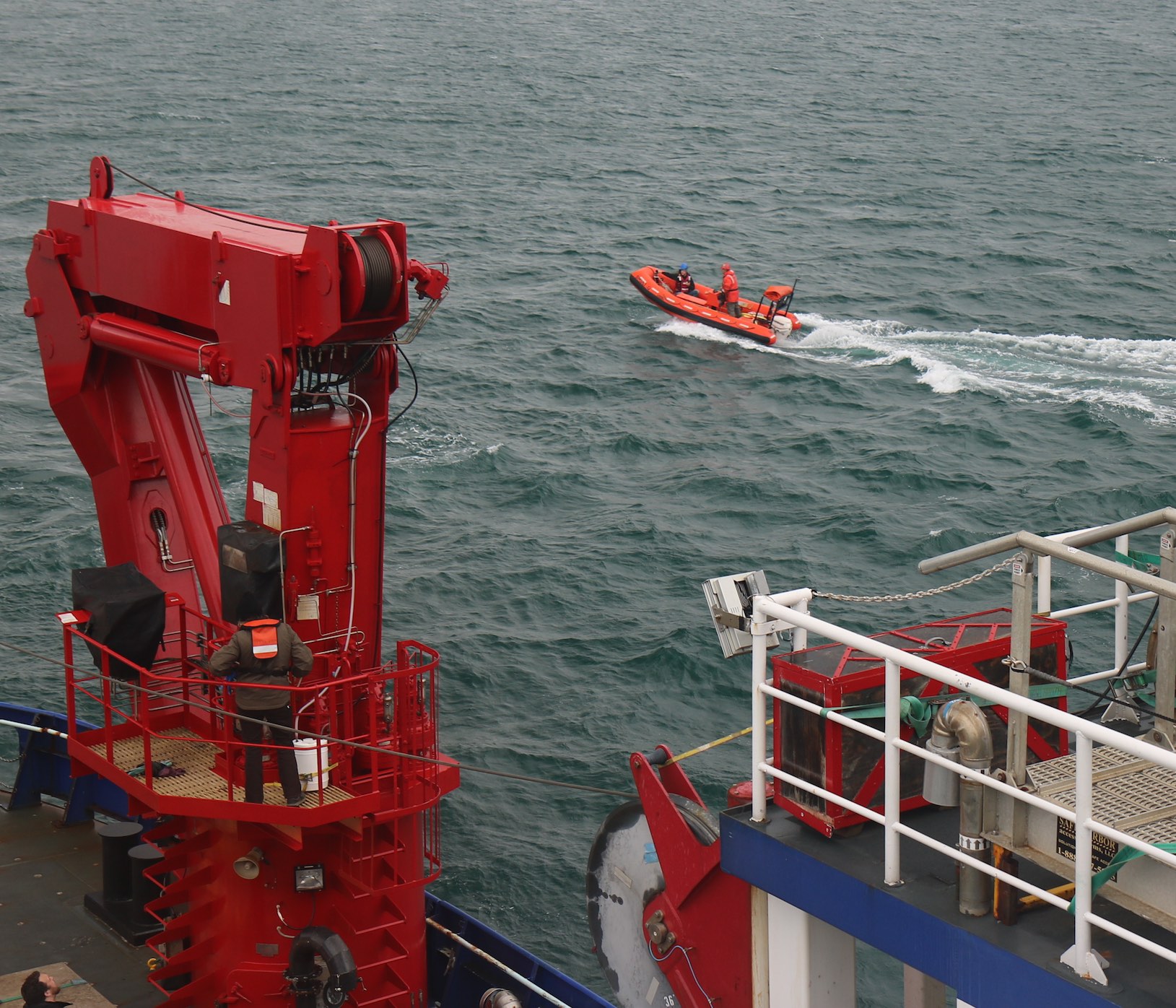 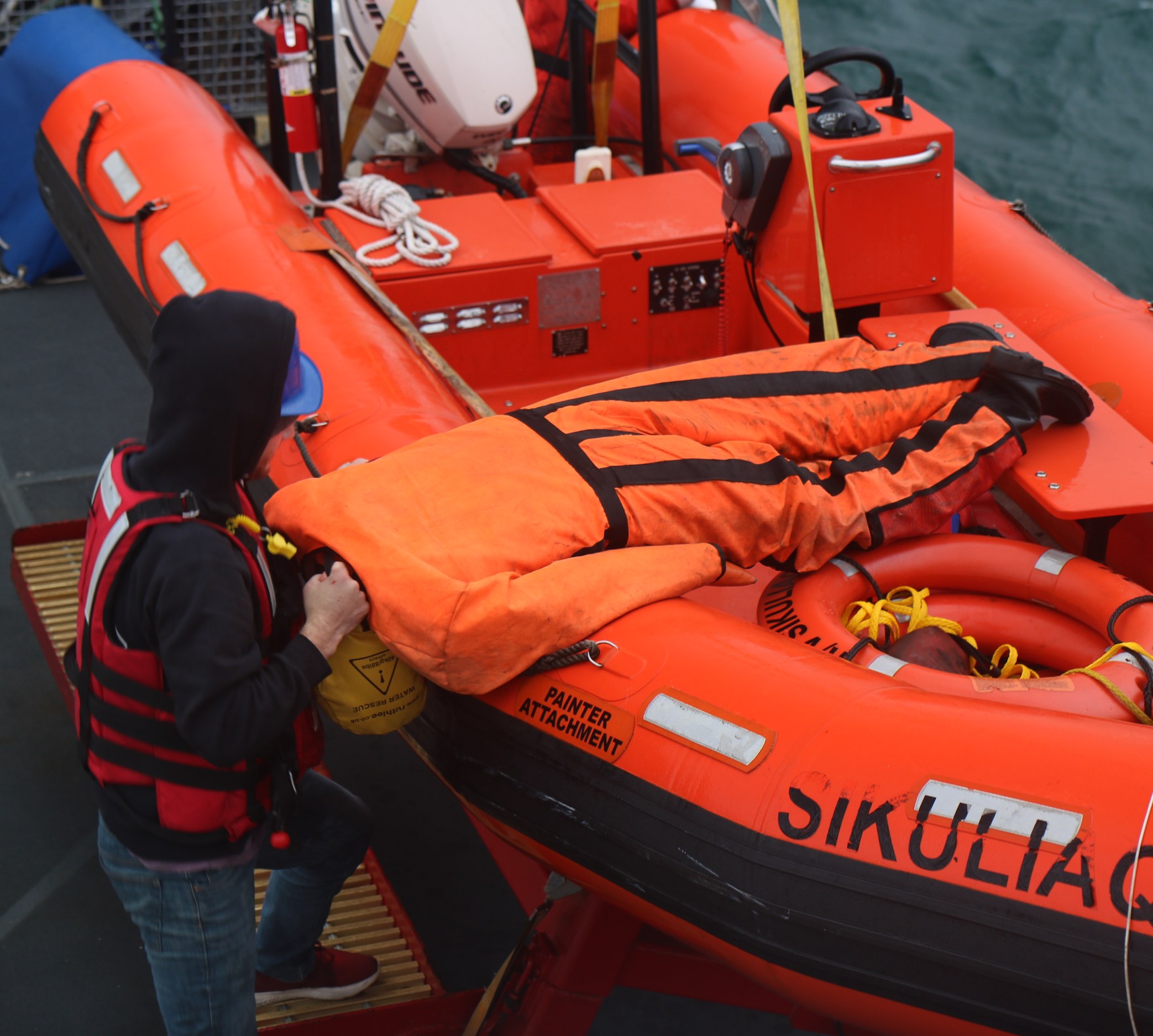
Sailing away from Seward with a deck full of gear.

We continued to mobilize in the morning, making sure everything in the lab
was tied down and ready for the rough weather that is forecast for our transit to station. We also had a safety
briefing and fire and boat drill. Embarrassingly, the Chief Scientist (not me this trip!) was not present for the
abandon ship roll call, having wandered ashore for one last time. We all practiced donning the survival suits,
which was useful because the Sikuliaq has a new type that is quite different from the traditional "gumby" suit.
We got underway just after noon and had a sendoff
by a small school of dolphin. The ship's personnel took advantage of the sheltered waters of the passage to do a
man overboard drill, which is reassuring, since when we are deep-towing our transmitter the ship won't have much
maneuverability, so in the unlikely event that anyone does go over the rescue boat will be a necessity.
Friday May 24. Our mobilization day. Started out slow because the ship was "bunkering"; filling
up with fuel. Fuel tankers were lined up at the dock - 8 all up I was told. That's half a fuel truck for each scientist.
I guess our carbon footprint is compromised for several years to come. My big job was terminating the deep tow cable, fitting
slip rings to the winch, and other sundry stuff to get our deep-towed transmitter, SUESI, up and running. By the end of the day
we were ready and she booted first time, and was able to transmit 75 amps into our test load. During real operations she
will be transmitting closer to 400 amps, but this is a really good start. With this success under out belt, we took the
evening off to have another meal in town and a few last drinks before turning in for the first night on the ship.
Thursday May 23. Up before 5am to catch flights to Anchorage. Security lines at SAN were a zoo
but TSA Precheck to the rescue. Flights flew as planned, which is really all you can hope for, and better than for some
of our colleagues coming from the east coast we found out. We drove from Anchorage to Seward (where the vessel, the Sikuliaq, has its
home port) in waves as people arrived. I was first, and scoped out what I thought might be the best restaurant in town.
When Jake arrived he had also identified The Cookery as a good prospect. He'd bought along a couple of bottles
of good wine, so a very pleasant time was had by all.
The Sikuliaq tied up at its home port.
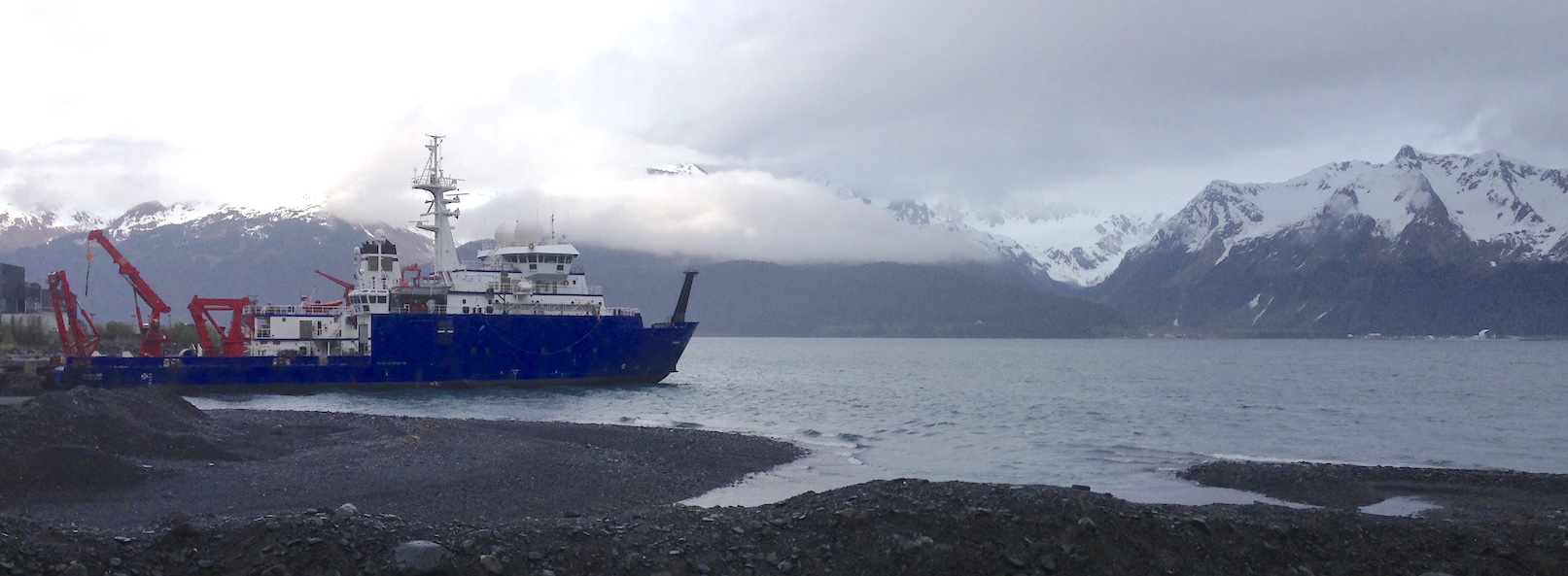
Wednesday May 22. Trying to get as much tidied up as possible before leaving. At first light tomorrow the Scripps team (Chris, Jake, and
Steve) will fly to Alaska for the start of the project. Well, the start of the cruise. The marine EM lab has been working hard
on getting all the instruments and gear ready for months. Here's a picture of the gear in the lab just before loading (image courtesy Chris).

A map of what we proposed to do.

|